Summary
98+ different animal species are at Sustainable Safari®. Please note some animals become unavailable due to rotation and scheduling.
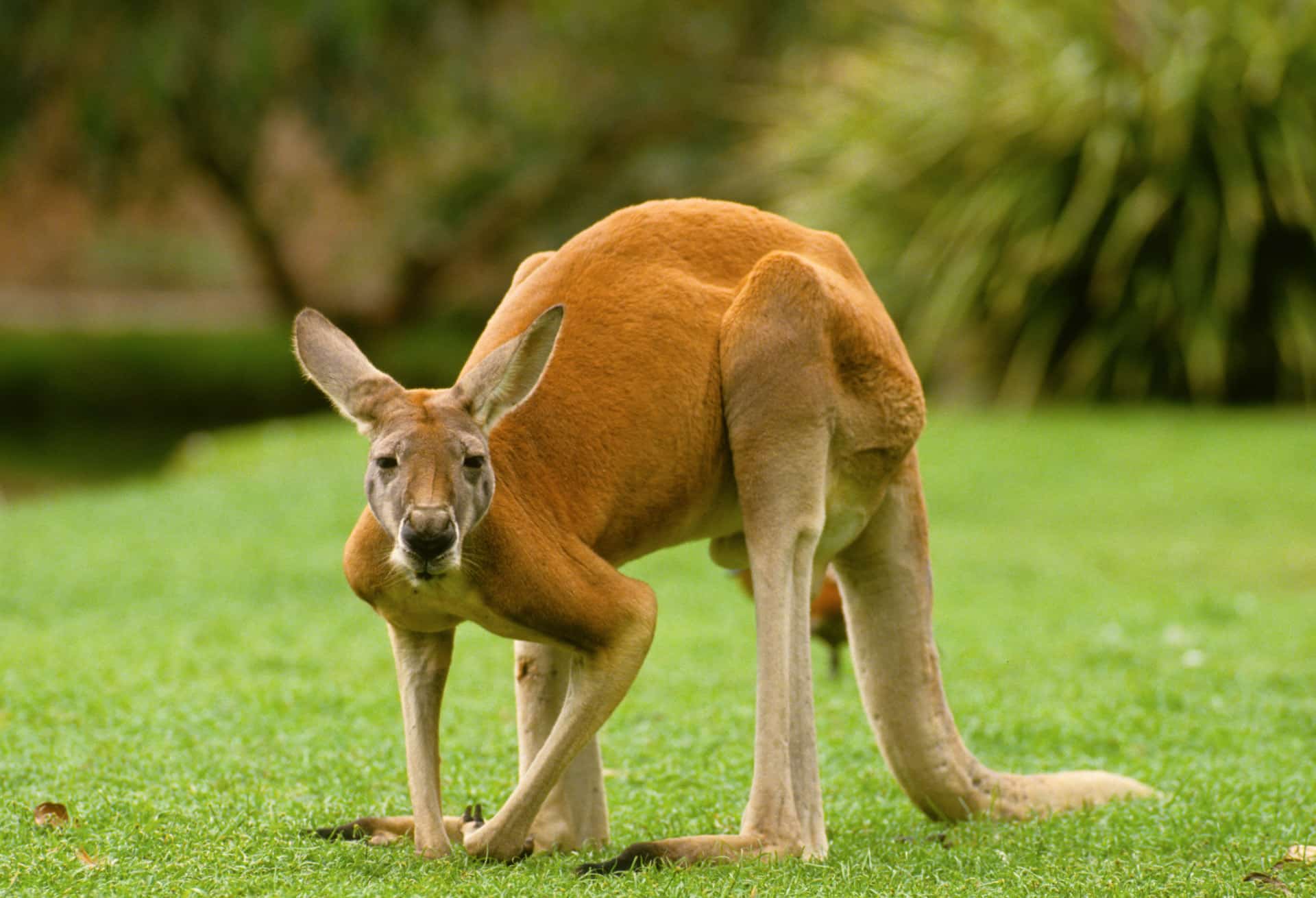
Safari Species List
Species at Sustainable Safari®
Sustainable Safari® has 98+ animal species to view or interact with! This page lists all Safari animal species.
To view the available animal interactions, visit the Safari animal interactions page.
Click the boxes below to learn more about each animal species.
Mammals & Marsupials
African Crested Porcupine (with video)
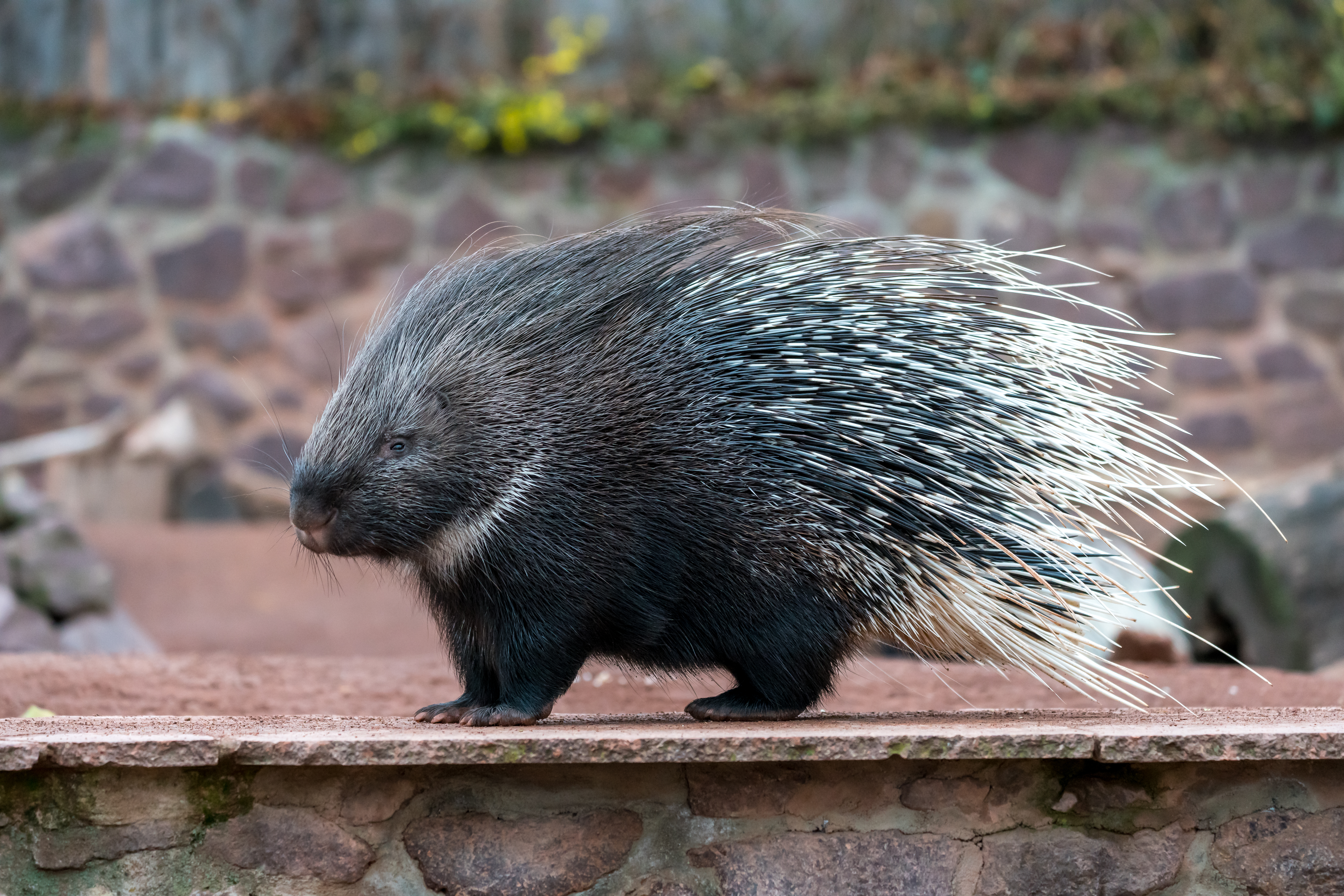
DIET | Herbivore – bark, roots, fallen fruits, and cultivated crops
- The African Crested Porcupine is the largest species of porcupine in the world. They are the second largest rodent in the world, after the capybara.
- The African porcupine is nocturnal and will do most foraging at night.
- It is a myth that porcupines can launch their quills. When confronted with predators, this porcupine raises its 18–22-inch quills into a sharp barrier between itself and predators.
- When threatened, porcupines stomp their feet to rattle their hollow tail quills to scare away predators.
African Hedgehog
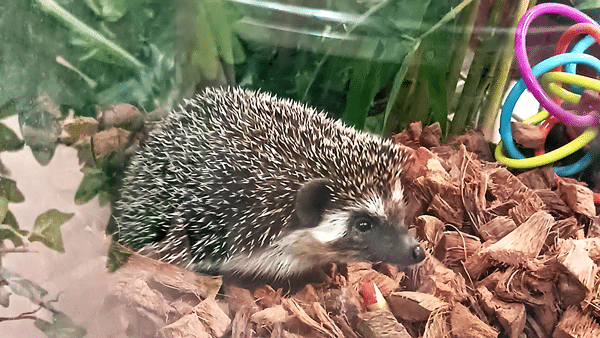
DIET | Omnivore – spiders, insects, roots, mushrooms, fruit, berries, snakes, toads, frogs, and bird eggs
- African hedgehogs communicate with snorts, hisses, chattering, and bird-like calls.
- They have high immunity to toxins and have been known to eat scorpions and even venomous snakes.
- Hedgehog quills are not barbed or poisonous. However, hedgehogs will apply foamy saliva to their quills. This may serve many purposes: an irritant to predators, a natural insect repellent since they cannot clean their skin well, or an attractant to potential mates.
- When provoked in the wild, the spines are used as a defensive mechanism to evade predators. A hedgehog’s spines are their first line of defense. They’ll roll up into a ball and erect their spines against their predator to form a protective barrier.
American Porcupine
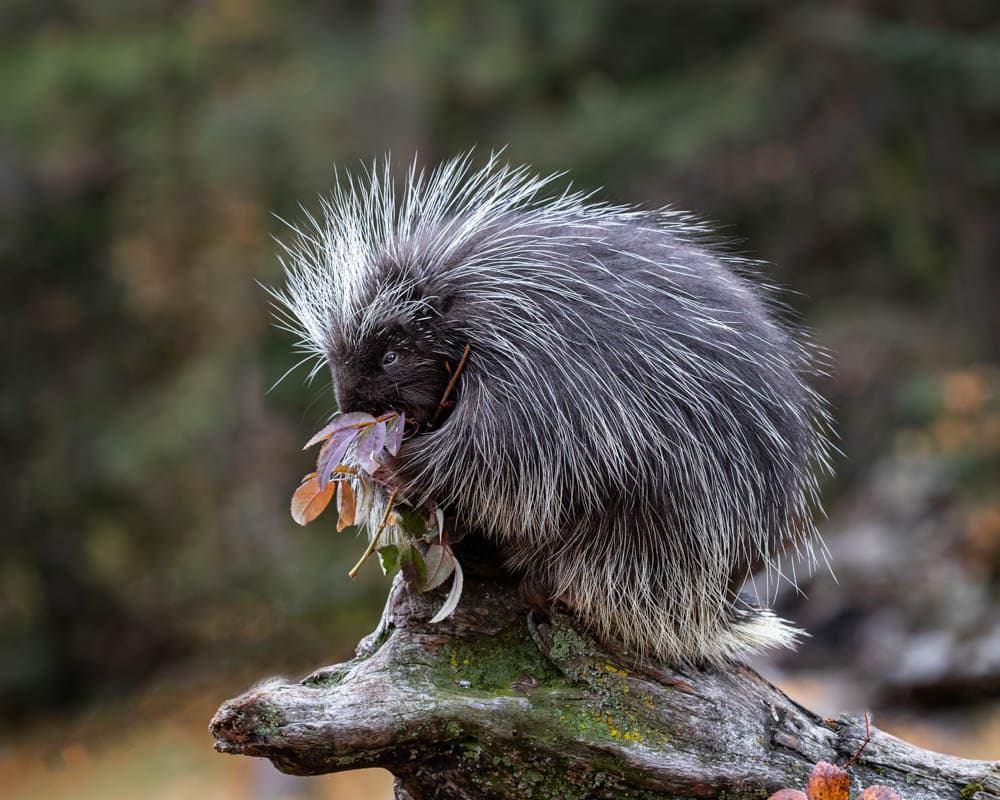
DIET | Herbivore – greens, roots, tubers, and bark.
- American porcupines spend most of their time on the ground but climb trees to forage for food.
- They are covered in over 25,000 barbed quills. It’s a common myth that they shoot them out, but that’s not true. Instead, they warn off predators by fanning their quills and slapping their tails on the ground. If the predator persists, the porcupine whips its tail into the animal, leaving its quills stuck in the predator’s skin.
- Baby porcupines are called porcupettes!
Agouti
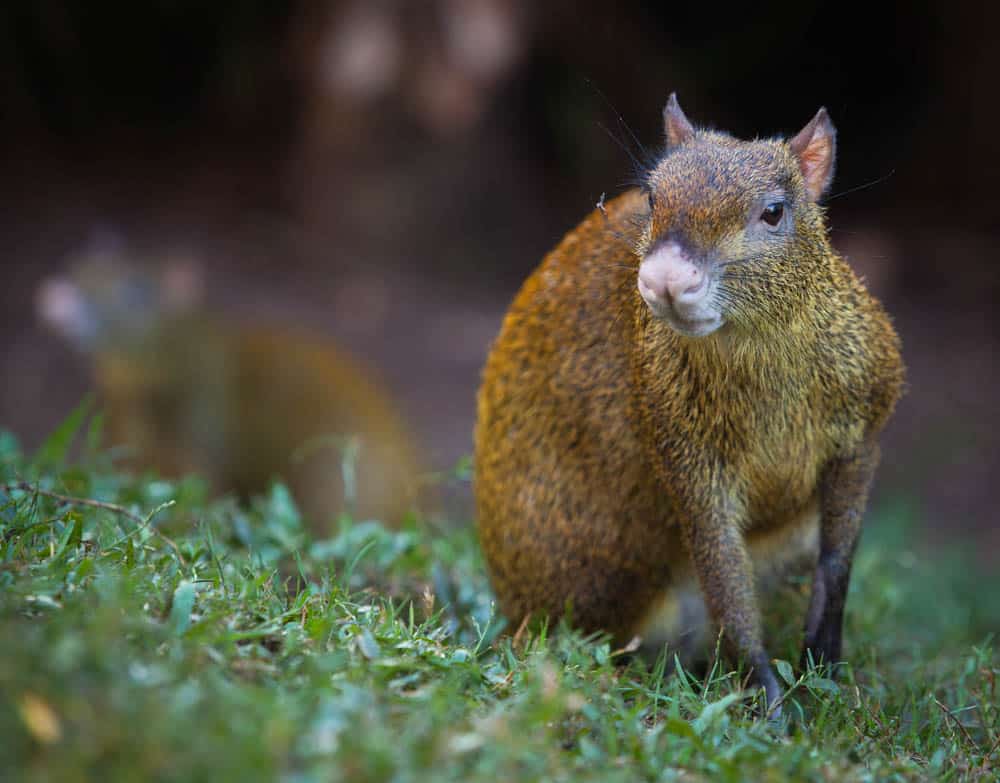
DIET | Herbivore – nuts, roots, and vegetation
- The name “agouti” is derived from either Guarani or Tupi, both South American indigenous languages, in which the name is written variously as agutí, agoutí, or acutí. The Portuguese term for these animals, cutia, is derived from this original naming.
- This animal is notorious for being able to open Brazil nuts, one of the hardest nuts to crack. They are vital to the growth and sustainability of the rainforests because they spread and bury seeds.
- When alarmed, its fur can stand up on end like a porcupine! This reaction is called piloerection when the hair stands on end. Humans have a similar reaction when we get goosebumps. The scientific name Dasyprocta means fuzzy butt!
- The agouti is a quick and agile animal. It can jump nearly 6 feet in the air. It can run only one hour after birth!
Armadillo (Hairy)
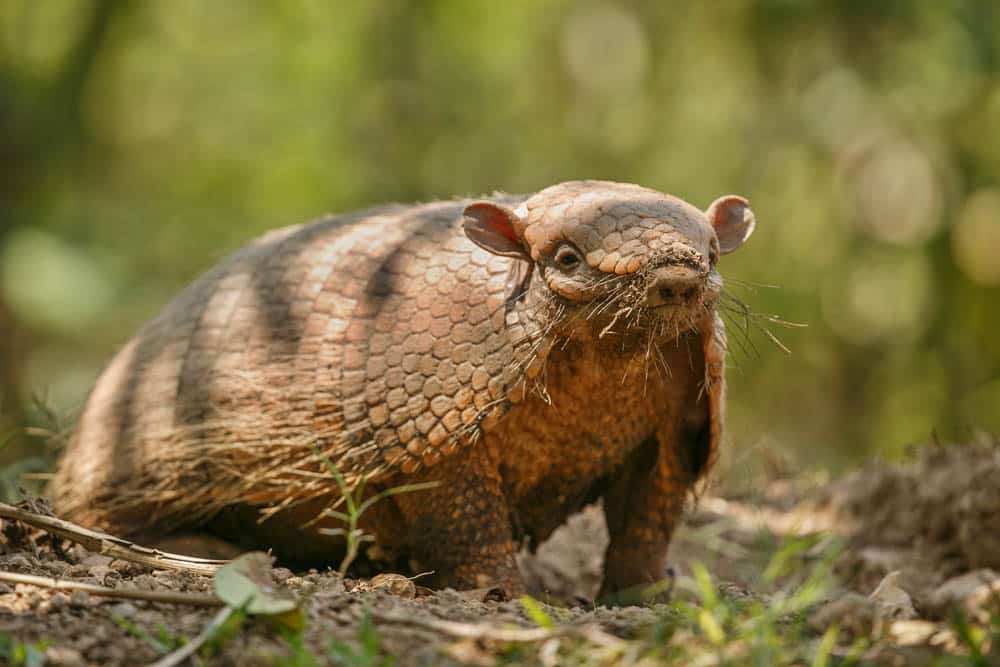
DIET | Omnivore – bugs, small vertebrates, and plant material
- The Screaming Hairy Armadillo gets its name from its habit of squealing like a pig when threatened and its hairy underbelly.
- The brown armor that covers their body is called a carapace and is made of keratin, the same material as human hair and fingernails.
- They cannot roll into a ball like the three-banded armadillo. Instead, they protect themselves from predators by hiding in their underground burrows.
- This animal is diurnal during the colder desert seasons and nocturnal during the hotter times.
Armadillo (Six-banded)
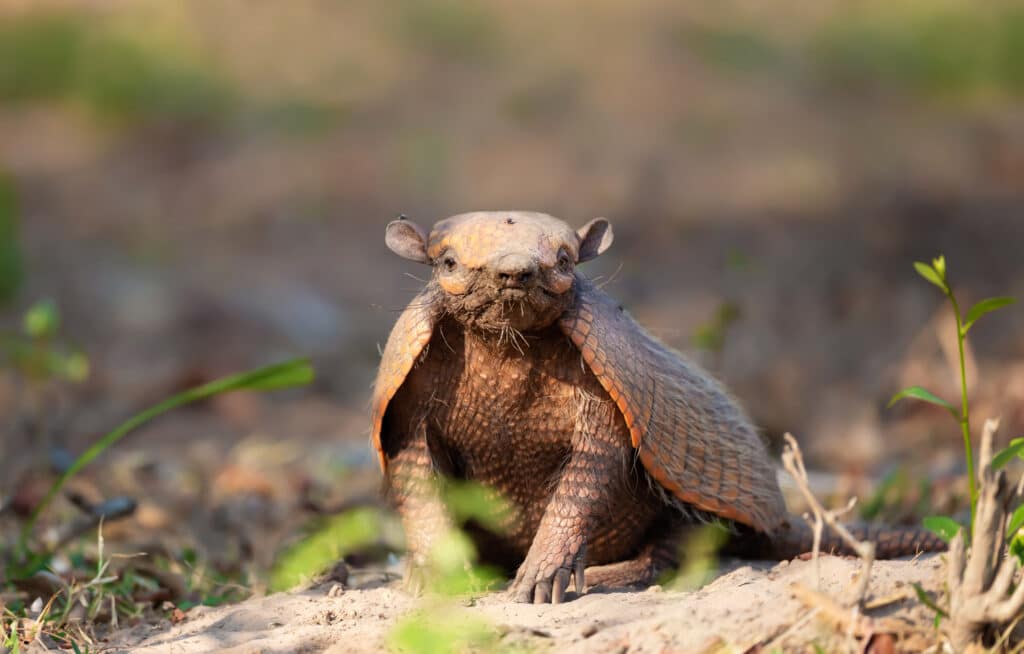
DIET | Omnivore – plants, fruits, bugs, and vegetation
- The six-banded armadillo is a nocturnal, terrestrial, and solitary animal that lives in dry habitats like deserts.
- They have very poor eyesight. They use their excellent sense of smell to find prey and to stay clear of predators.
- Armadillo armor is made of thick plates of bone covered in keratin. Keratin is the same material as human fingernails!
- They can’t roll into a ball like the three-banded armadillo. Instead, they are excellent diggers, which help provide cover from any predators.
Asian Small-clawed Otter
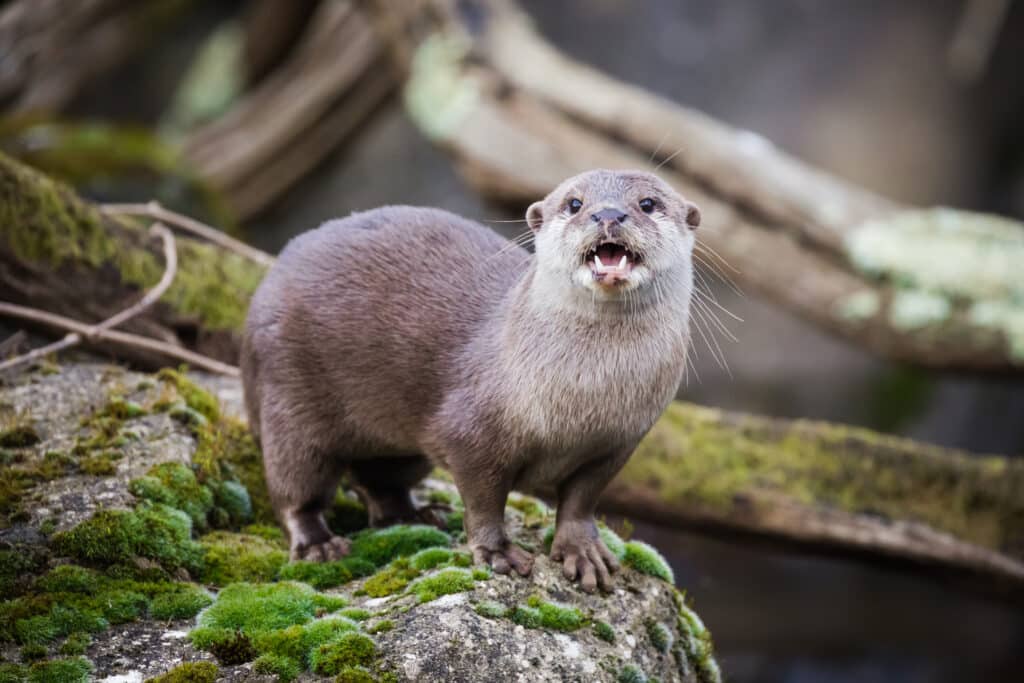
DIET | Carnivore – fish, frogs, crustaceans, insects, and snakes
- The Small-clawed Otter is built for swimming. Their bodies are well adapted to it as well. They have a powerful tail that helps them change direction in the water. They also can close off their ears and nostrils to keep water out.
- Otters are highly social animals. They do well in groups of 3 or more, using several calls and yips for communication.
- They are monogamous, mating with the same partner their entire lives.
- Their fur is so dense that they have over 450,000 hairs per square inch!
Binturong / Bearcat (with video)

DIET | Omnivore – fruits, small animals, eggs, and bugs
- This animal is incredibly agile and can easily hop through thick forest trees.
- The binturong is the largest animal in the world with a prehensile tail, which they hang upside down or securely onto the trees.
- Do you smell buttered popcorn? That’s the natural musk of the binturong!
- Binturongs, nicknamed bearcats for obvious reasons, are classified with a small family of carnivorous mammals called Viverrids.
Bush Baby
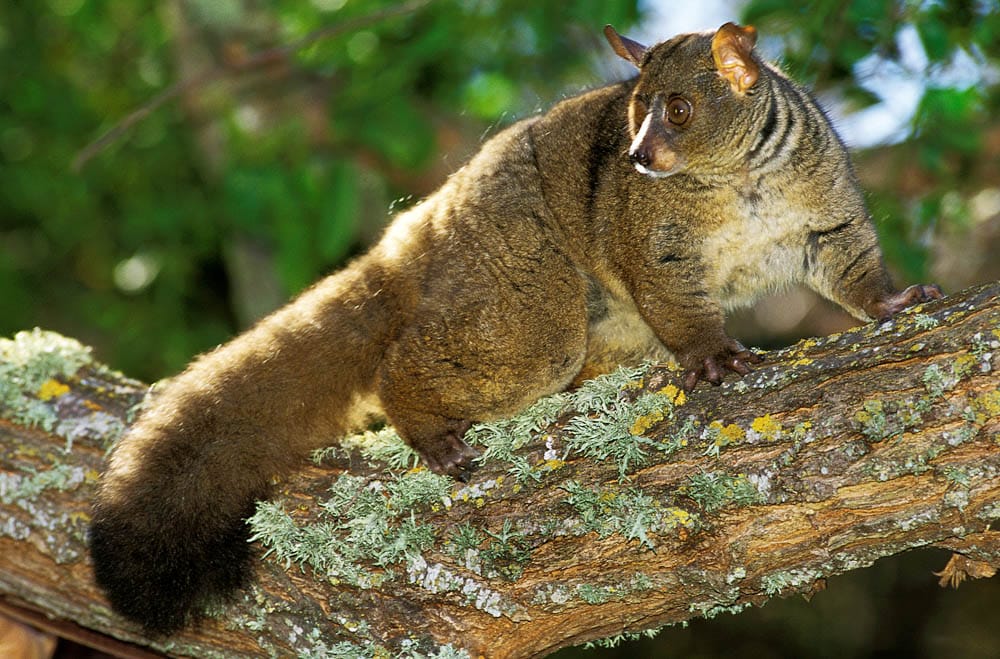
DIET | Omnivore – plants, fruit, tree sap, small prey, and insects
- The bushbaby, also known as the brown greater galago, is a nocturnal animal with huge eyes that catch the light even in the darkest environments. They are often called night monkeys.
- They are found in forests all across Africa. They easily blend into their environment with their dark brown fur.
- This animal is very territorial, often showing aggression when lesser animals enter its territory. They mark their territory by urinating on their hands and jumping from trees to spread their scent.
Capybara (with video)
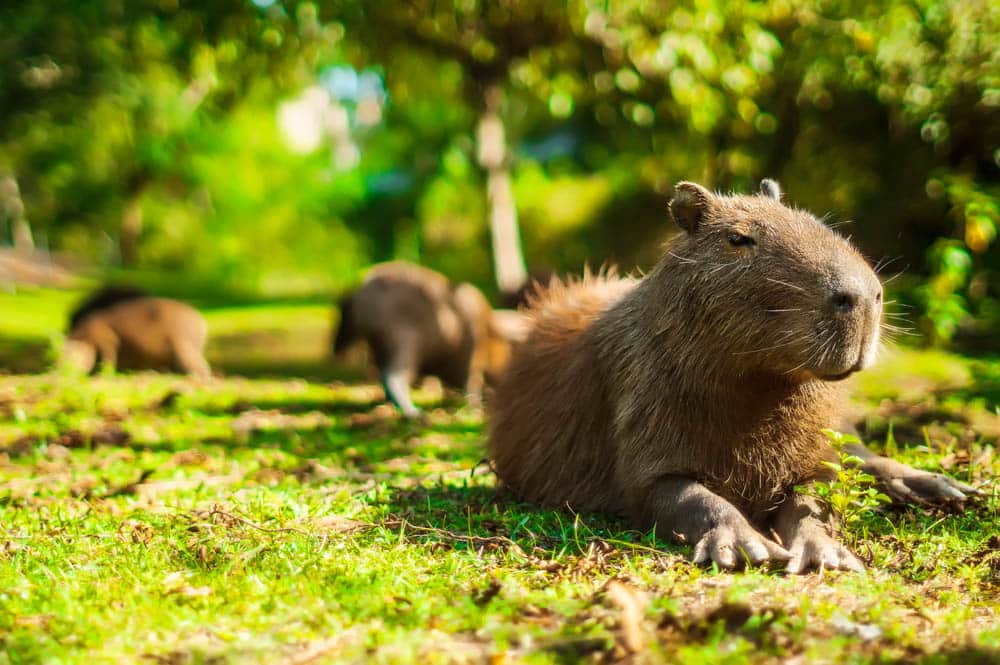
DIET | Herbivore – plants and grasses
- This animal is semiaquatic and spends most of its day in or around bodies of water. They are excellent swimmers and can hold their breath for up to five minutes.
- Capys have a wide range of calls. They can make high-pitched squeals to indicate excitement or bark like a dog to warn others of danger.
- Capybara is the world’s largest rodent. The smallest rodent is the Pygmy Jerboa, which is a tiny mouse.
Cavy (Patagonian mara)
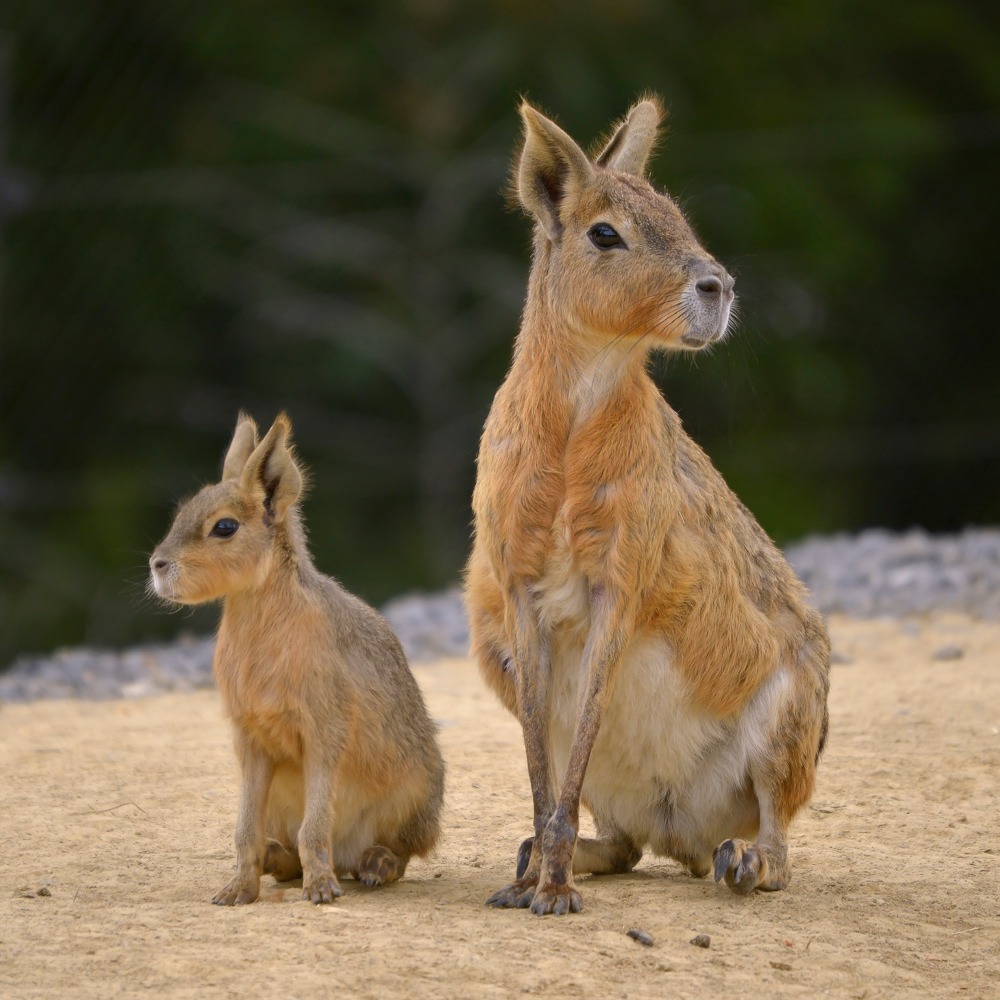
DIET | Herbivore – grass, greenery, shrubs, and seeds
- This animal has exceptionally keen senses and is always on high alert for predators, often fleeing at the slightest sign of danger.
- Patagonian Cavies have one to three pups per litter. They communally care for their young while the males watch for predators.
- Patagonian Cavies are monogamous and mate for life.
- Cavies are in the rodent family.
Chinchilla (with video)
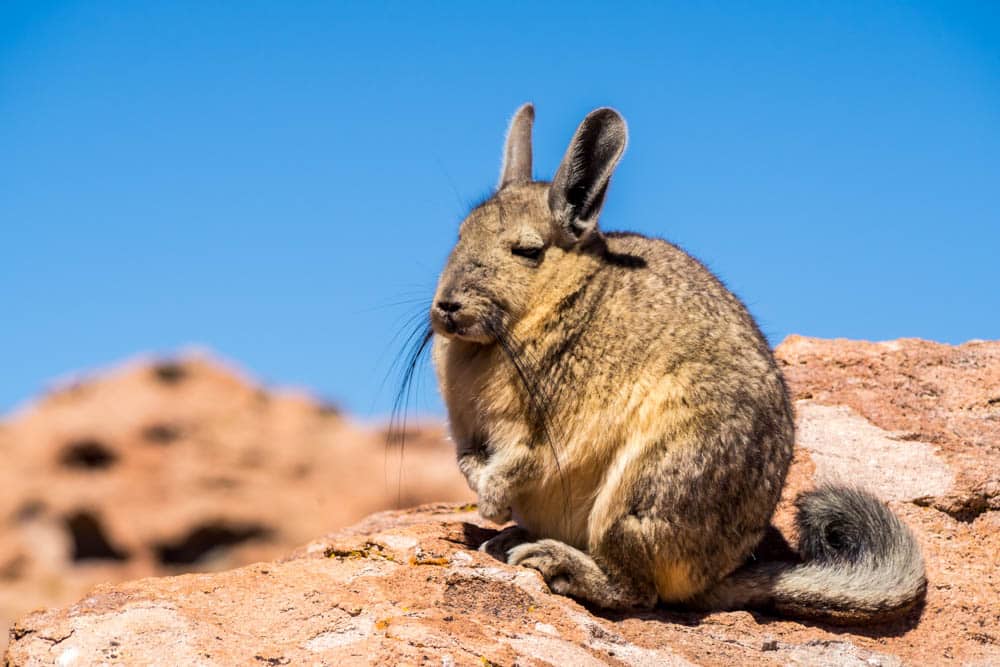
DIET | Primarily herbivorous – vegetation, grass, seeds, leaves, and bugs
- The Chinchilla lives in mountainous areas. They live in crevices and dens at elevations of up to 16,000 feet. They thrive in cold temperatures.
- Chinchillas have incredibly dense fur, with up to 100 hairs per follicle. Humans have only 1-3 hairs per follicle.
- They have a unique defense mechanism against predators known as the “fur slip” when the chinchilla feels threatened. They create a diversion by releasing large clumps of fur, distracting the predator so the chinchilla can quickly escape.
Continental giant rabbit
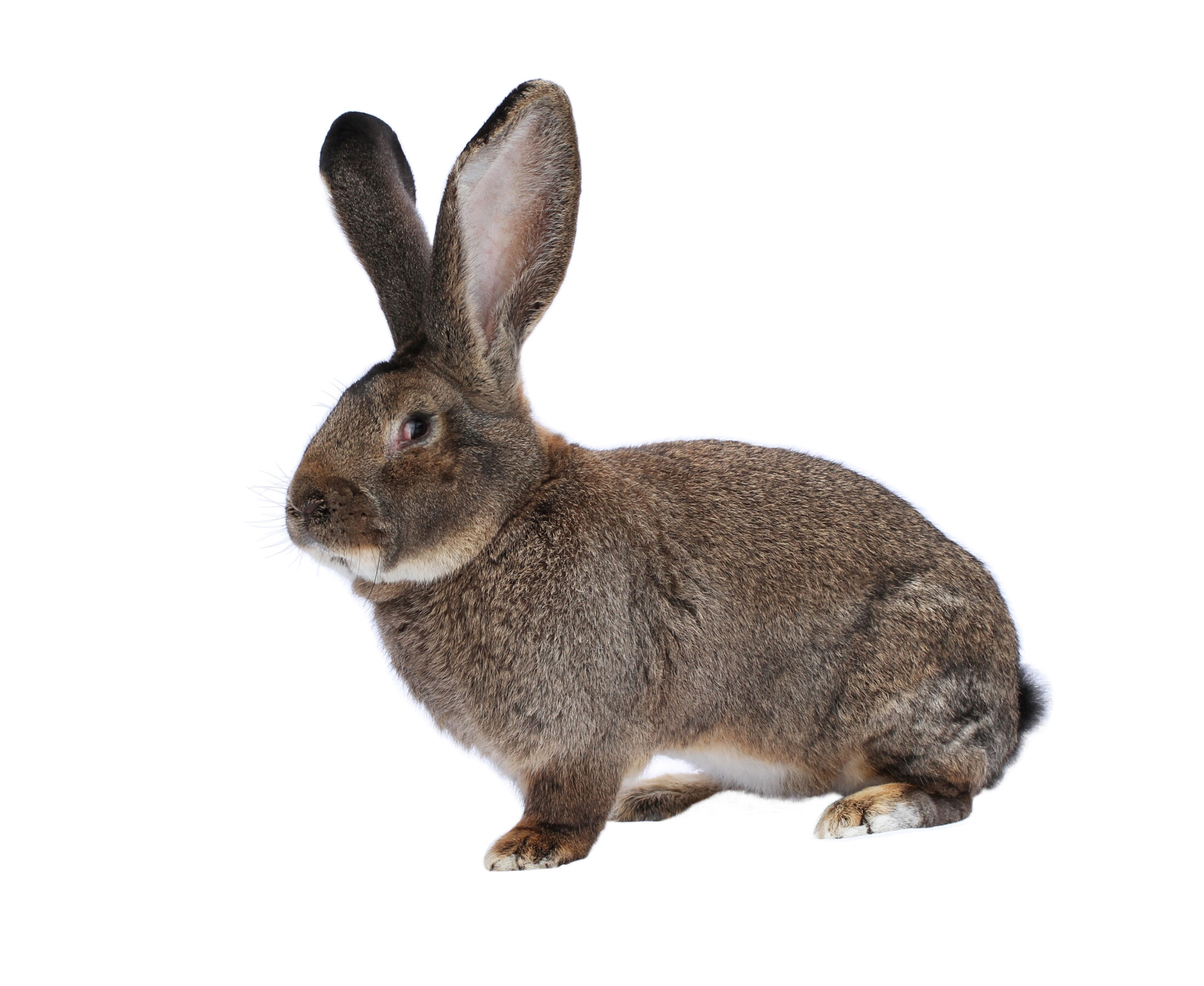
DIET | Herbivore – grass, flowers, and vegetation
- The Continental Giant is also called the German Giant rabbit or the Conti and is thought to descend from the larger Flemish Giant.
- They have powerfully muscled hindquarters and legs they can use to kick predators away.
- During the 19th century, they were imported to the US from Europe and the UK to help increase the size of rabbits used for meat.
- As kittens, if they feel threatened by a predator, they will release a high-pitched screaming noise to alert mom or try to scare away the predator.
Fennec Fox
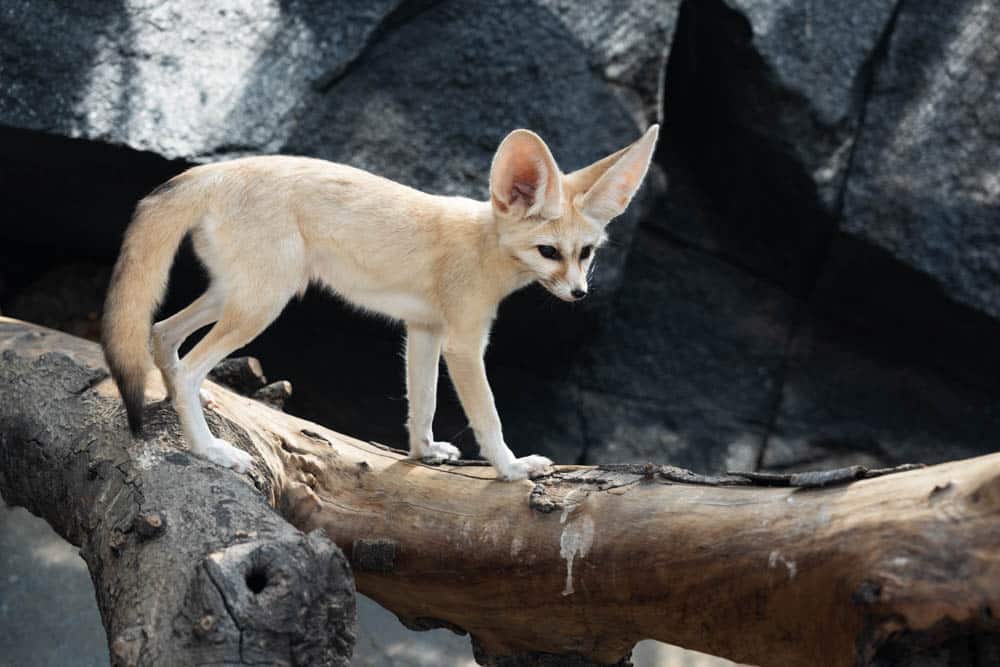
DIET | Omnivore – grasshoppers, locusts, worms, fruits, vegetation, and small prey
- The Fennec Foxes have excellent hearing. They use it to locate small prey under the ground.
- They are desert animals and have adapted well to this environment. Their pale fur allows them to blend into the sand. They are also nocturnal, allowing them to sleep in their cool burrows during the hottest parts of the day.
- Their ears work like built-in AC units, blood vessels catching cool breezes and circulating the coolness through their body.
Genet
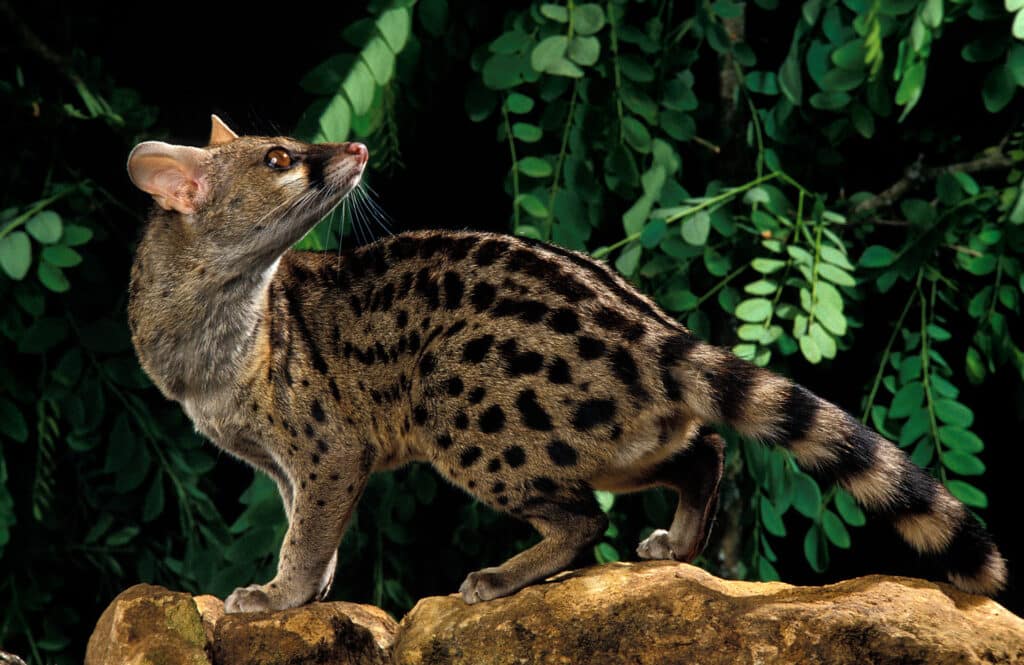
DIET | Carnivore – birds, eggs, small vertebrates, frogs, and bugs
- The genet is a cat-like animal in the Vivveridae family, related to civets and the binturong.
- Their babies are called kittens, even though they aren’t related to cats.
- They are considered arboreal animals because they spend much of their time in trees hunting for food, but they seek shelter on the ground in bushes and dens.
- They are very territorial and can secrete a foul-smelling substance when threatened to scare off enemies.
- There are about 30 subspecies of genets across Africa, Europe, and the Middle East.
Goat Pygmy/Fainting (with video)
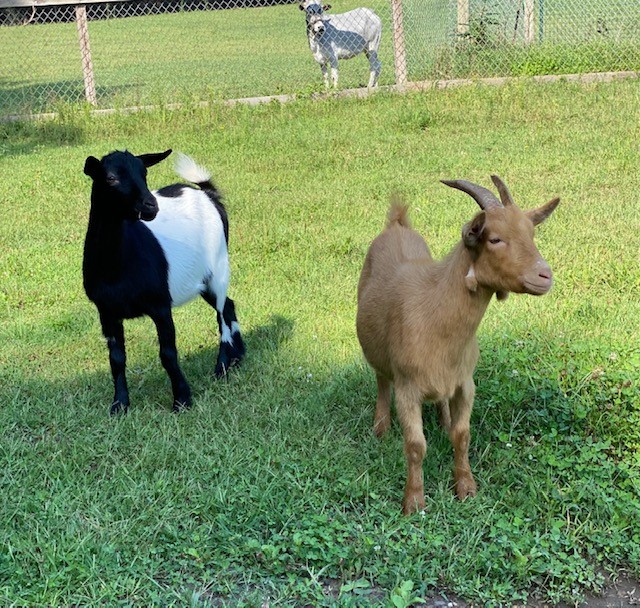
DIET | Herbivore – grass, hay, corn, and vegetation.
- They are hardy, can withstand most climates, and exist worldwide as one of the most popular farm animals.
- Their coat is naturally waterproof.
- From a young age, they learn the agility to climb high places to avoid predators or reach greenery.
- Goats have two-toed hooves with padding and a hard shell. These pads can spread apart, applying control and balance to strengthen their grip.
Greater Grison

DIET | Carnivore – small prey and fruit
- The grison is in the mustelid family, related to otters, badgers, and minks.
- They produce a foul-smelling fluid to mark their territory and warn off predators when threatened.
- They are primarily diurnal. However, they will be active during the night as well.
- They are usually found by themselves as territorial animals, but they pair up during mating.
Guinea Pig
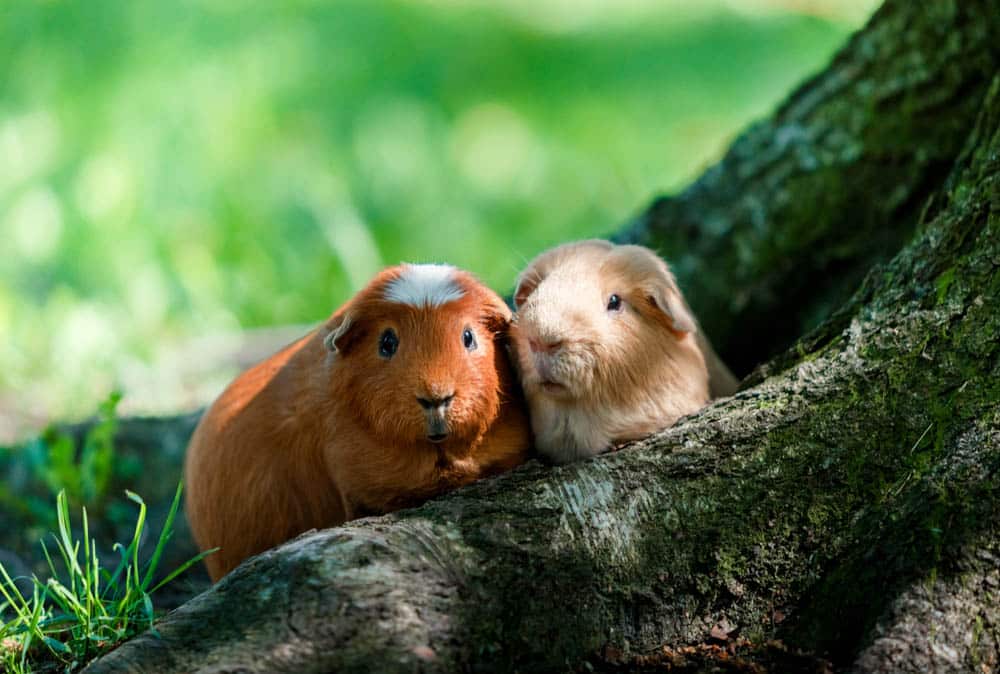
DIET | Herbivores – leaves, twigs, flowers, grasses, and fruit
- Despite being called guinea pigs, they are not in the pig family nor from Papua New Guinea. They are South American rodents.
- Male guinea pigs are called boars, while females are called sows. Babies are called pups.
- They are highly social animals, often found in groups of 10 or more in the wild.
- When excited, they jump up and down while yipping. This is called “popcorning”!
Kinkajou
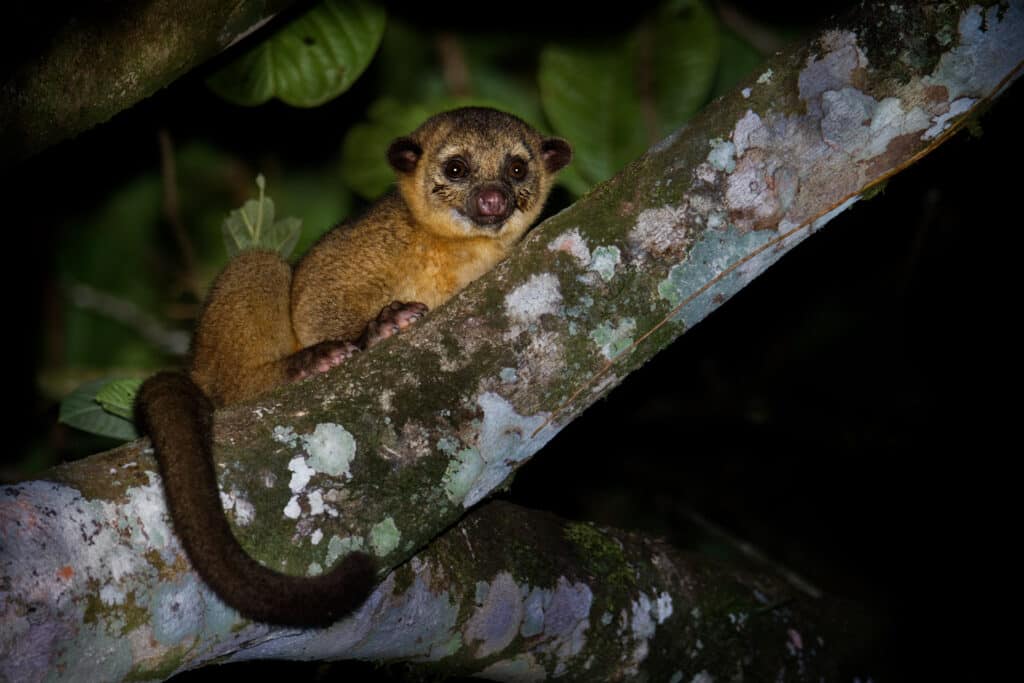
DIET | Frugivore – fruit and nectar
- The Kinkajou, also known as the “honey bear,” is a relative of raccoons and coatimundis.
- They have a long, narrow tongue, which they use to lap up flower nectar and honey from beehives.
- Kinkajous are essential pollinators. They catch the pollen of flowers on their faces and spread it as they go from flower to flower, drinking the nectar.
- They can turn their feet in the opposite direction and run backward as swiftly as forwards! They also have long, prehensile tails that aid them in climbing through trees.
Kusimanse
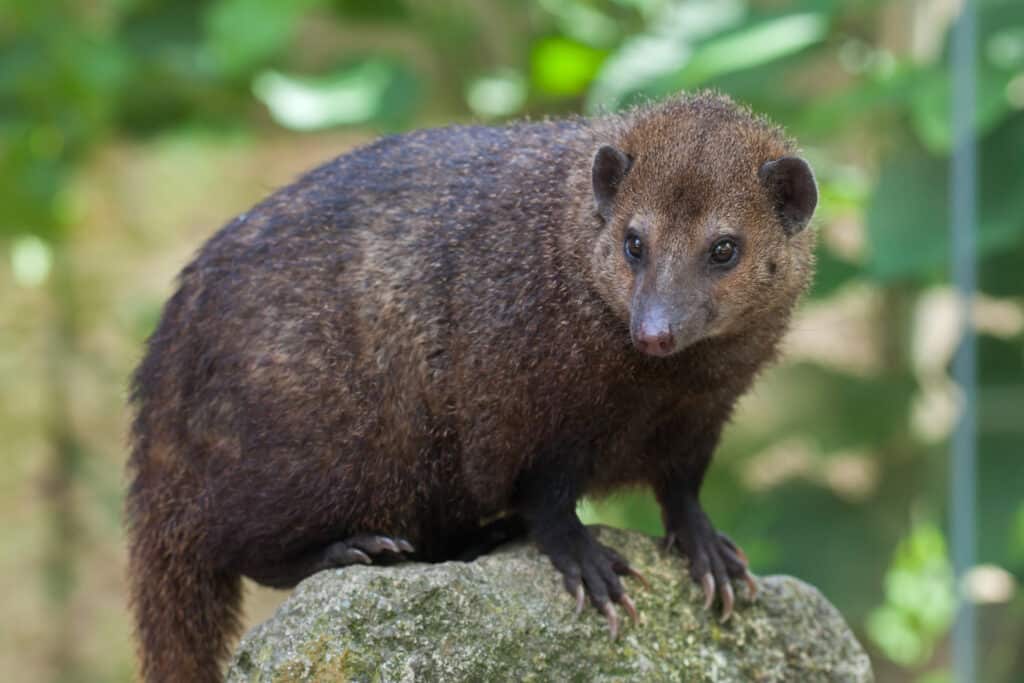
DIET | Omnivore – bugs, larvae, crabs, snails, small rodents, and fruit
- The Common Kusimanse is part of the Mongoose family. The Kusianse is also known as the “dwarf mongoose.”
- They are highly social animals that live in groups of 10-20 individuals. They are territorial animals. They use scent glands to mark their territory to ward off predators. It will aggressively defend its home against all kinds of intruders.
- They are diurnal animals, playing and preying during the day.
- They are excellent diggers. They will dig out their dens or homes in the ground.
Lowland Paca
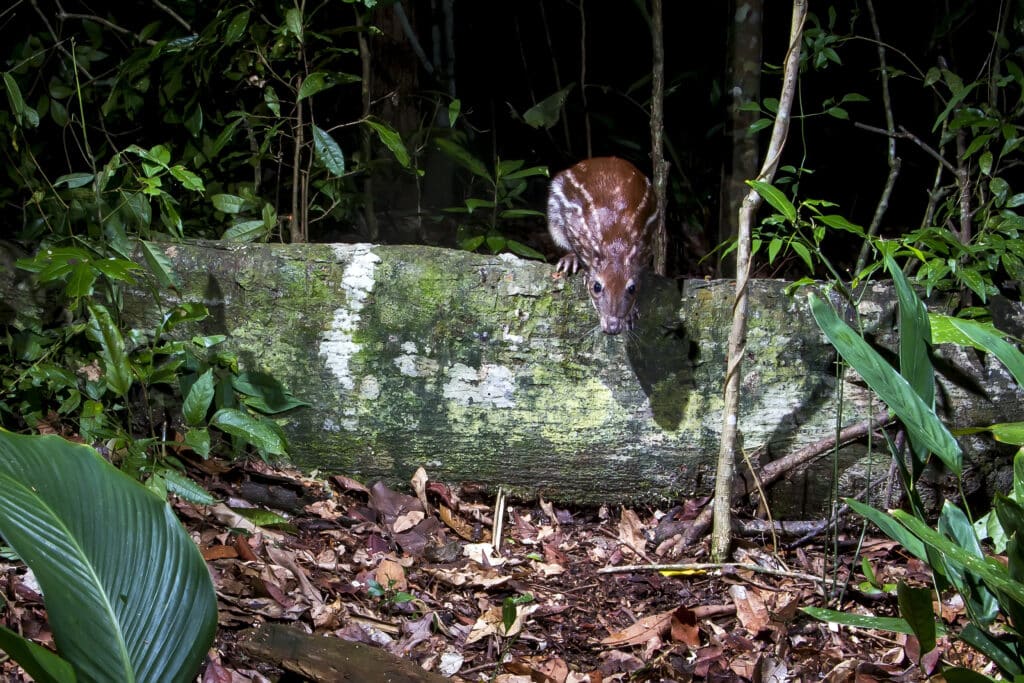
DIET | Herbivore – leaves, twigs, flowers, grasses, and fruit.
- The lowland paca, also known as the “gib nut” or the “royal rat” is a part of the rodent family.
- Lowland pacas are monogamous and mate for life, producing up to two babies per year.
- They are primarily nocturnal and solitary, not socializing with other pacas unless they are part of the same family unit.
- They are highly suspicious animals and will often flee at the slightest sign of danger. If they are near water, they will even swim away to safety.
Marmoset (with video)
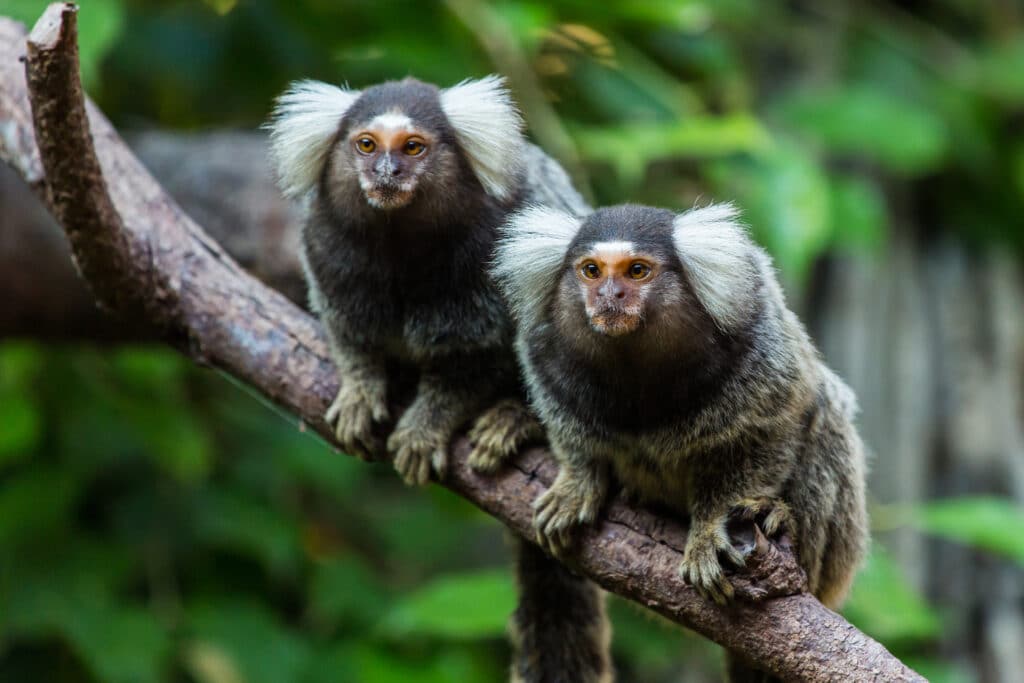
DIET | Frugivores – primarily fruits or sap and bugs
- The common marmoset is a highly social animal, forming family units of 2-15 individuals.
- They are highly territorial animals, marking their homes with the scents from their scrotal glands all over their home trees.
- They cling to their mother’s back for the first few weeks of life.
- The common marmoset is diurnal. This means that they are most active during the day. During the night, they cuddle one another.
Miniature Zebu
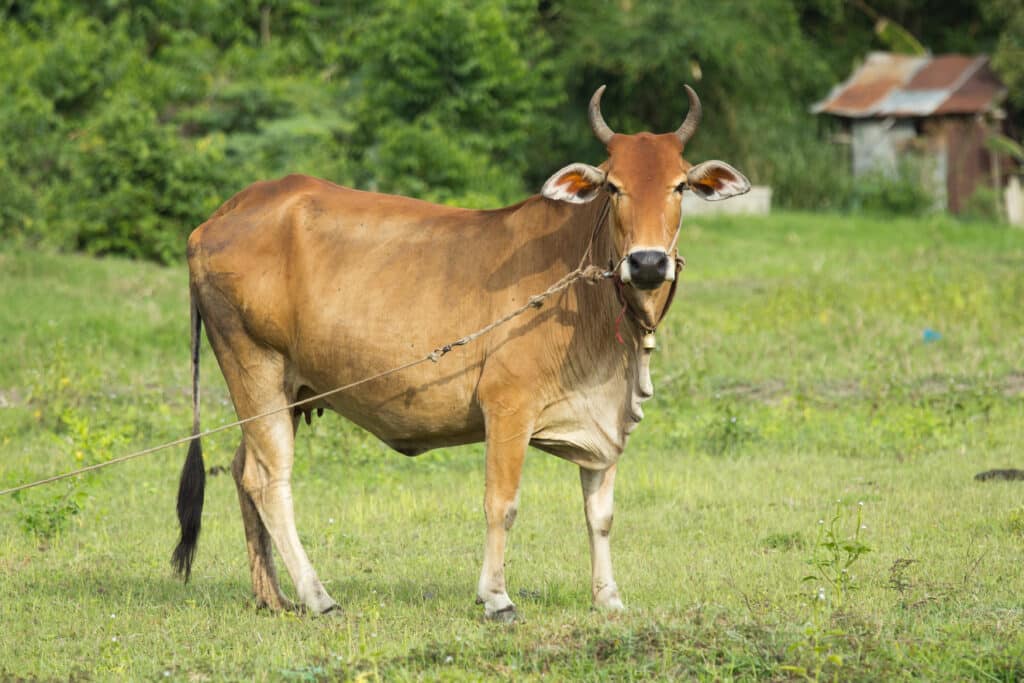
DIET | Herbivore – grass and vegetation
- The miniature zebu is a herd animal, meaning they travel in large groups of their species for protection from predators.
- In India, the zebu is considered sacred, and eating them is prohibited.
- Like a camel, the miniature zebu has a hump on its back that is used for fat storage in times of food scarcity. They also use their humps to help dissipate their body heat.
- The zebu has been domesticated to be productive for farming in hot and humid climates.
Mountian Coatimundi (with video)
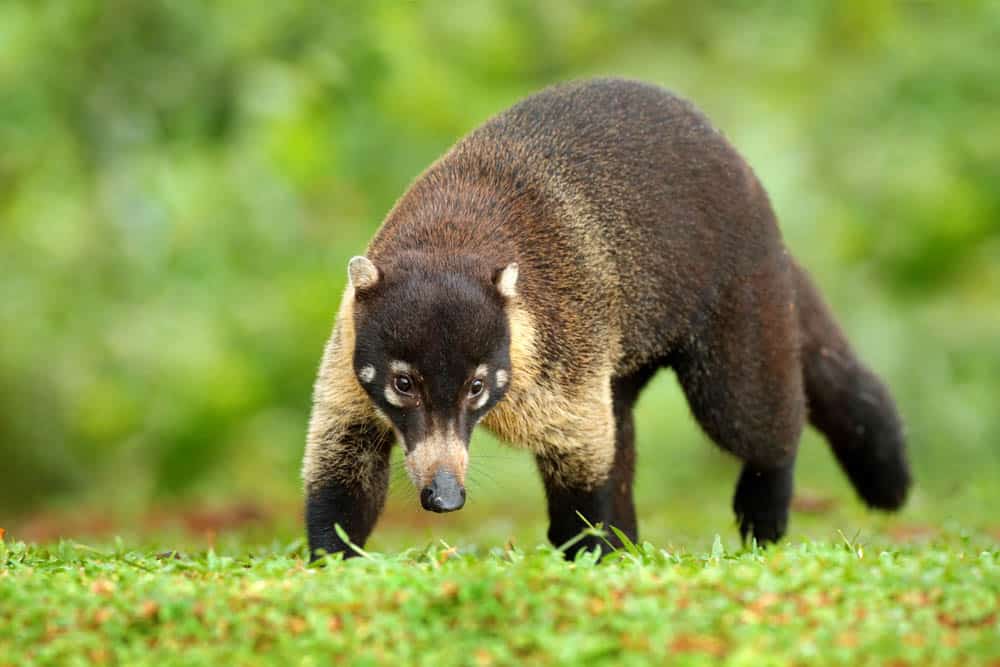
DIET | Omnivore – small prey, fruits, berries, and insects
- The Coatimundi is a distant relative of the raccoon. They are in the family Procyonidae.
- A group of coatimundis is called a band. Each band contains anywhere from 15 to 20 individuals.
- Coatis are curious and resourceful creatures, often found around highly populated human areas, scrounging for leftover foods.
- The Coati is a diurnal animal that is most active during the daytime. During the night, they cuddle up together to sleep in the trees.
Muntjac Deer
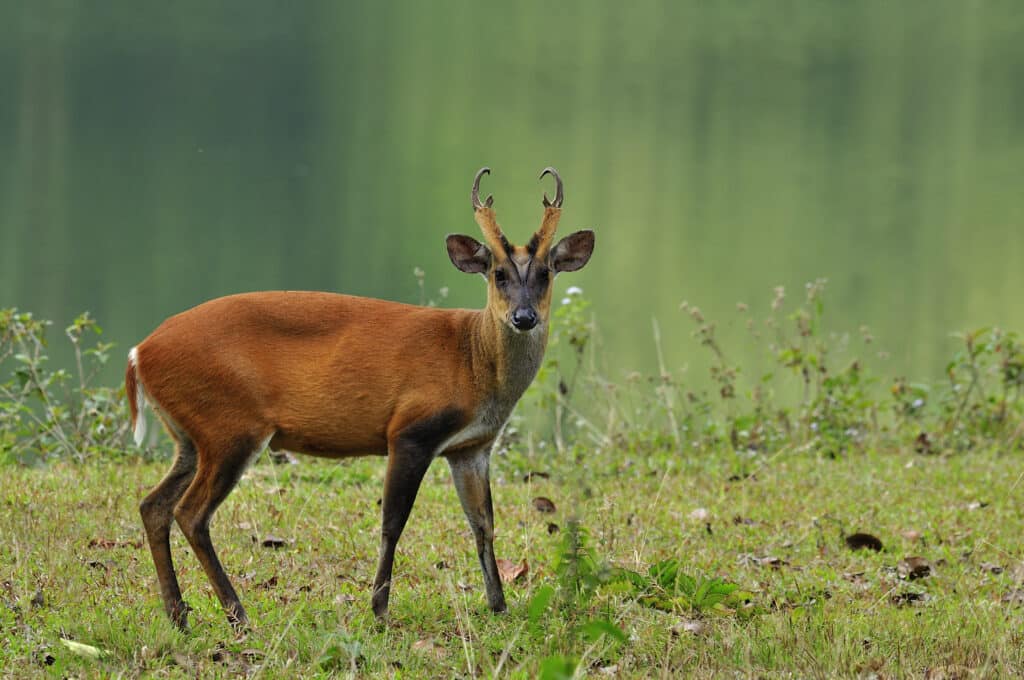
DIET | Herbivore – shrubs, herbs, flowers, and vegetation
- The Reeves’s Muntjac is a solitary animal. It dislikes other muntjacs in its territory and will fight but is open to mates during the mating season.
- The Muntjac is also known as the barking deer. They bark when alarmed, sounding similar to a big dog.
- They are native to Asia but have a thriving European population after being introduced in the 19th century.
- Muntjac has large scent glands under their eyes that they can open up to clean with their long tongue.
Olingo
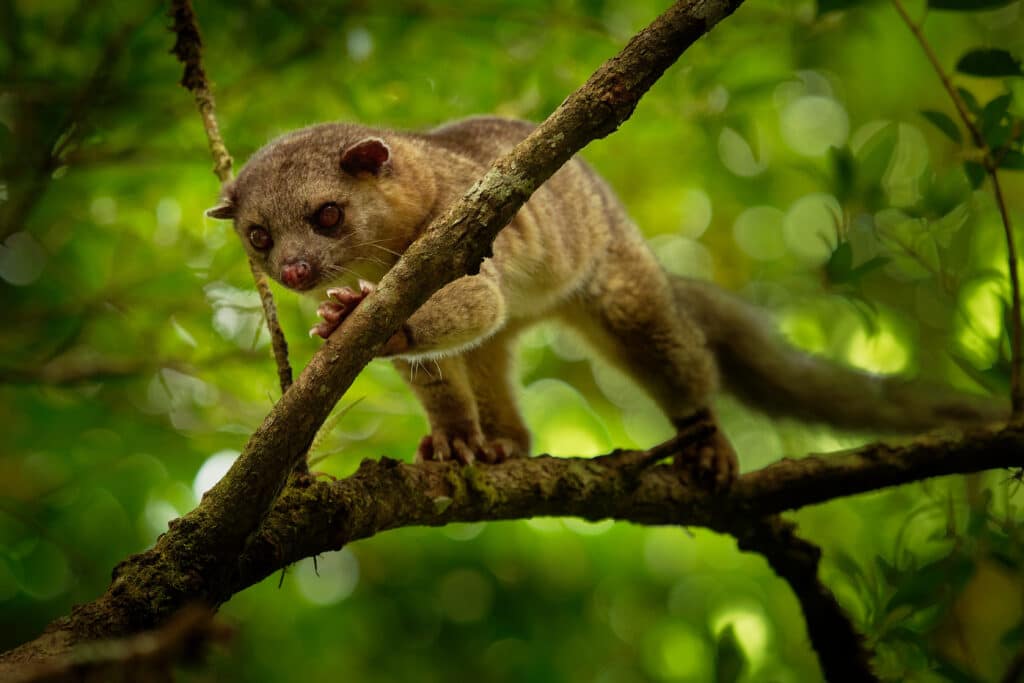
DIET | Frugivore – fruits, honey, and flower sap
- The Olingo is in the Procyonidae family, so they are related to raccoons, ringtail cats, kinkajous, and coatimundis. Although they highly resemble the kinkajou, its cousin, you can distinguish them from one another by their tails. The olingo’s tail is far bushier than the kinkajous.
- They can turn their feet in the opposite direction and run backward just as swiftly as running forwards!
- They prefer to live in pairs but are otherwise very solitary animals.
Owl Monkey
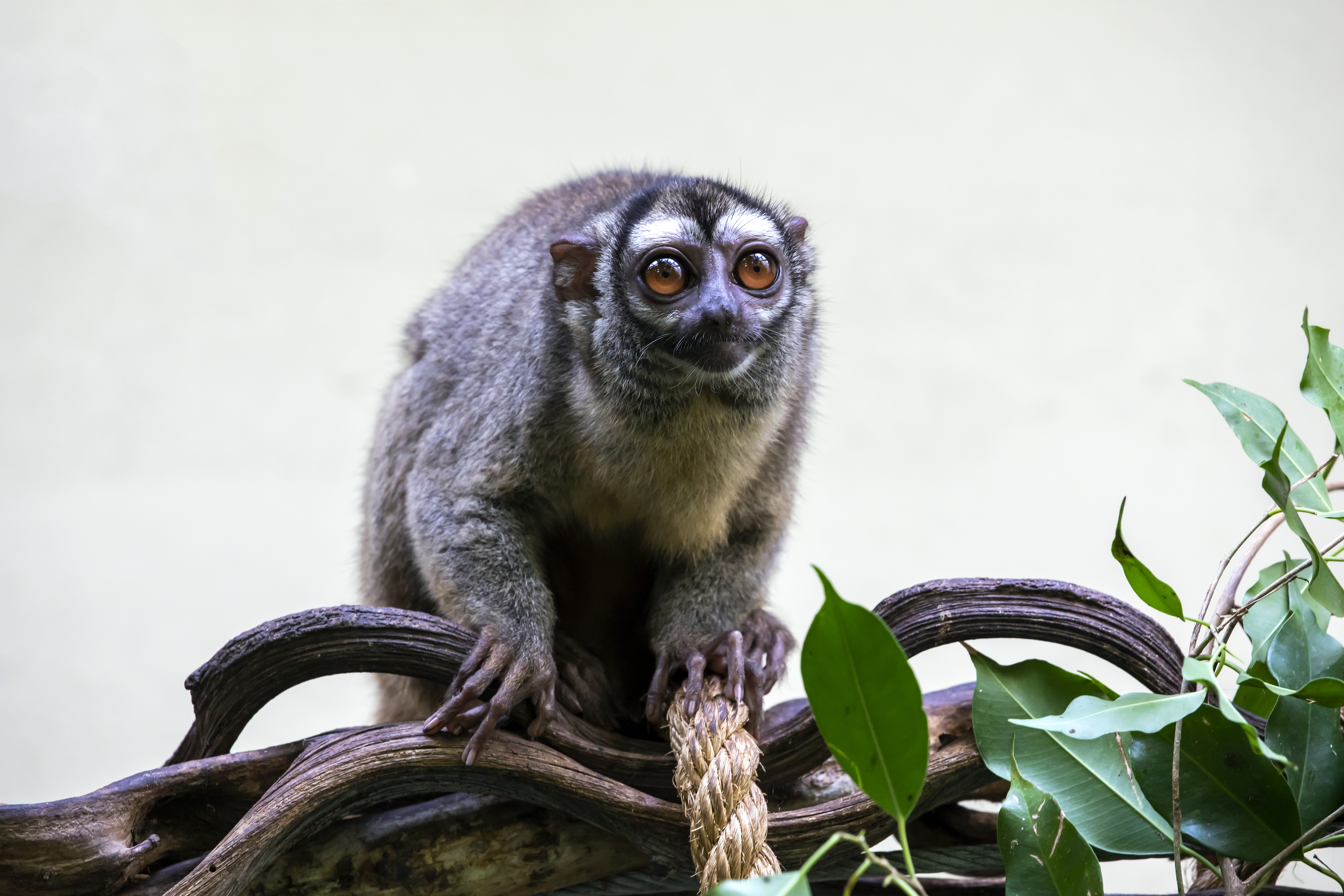
DIET | Omnivore – bugs, fruits, eggs, and vegetation
- The owl monkey (the “night monkey”) is a small nocturnal primate from South America.
- They never stray far from their territories, claiming one or two trees as their territory and only leaving to eat.
- Baby owl monkeys cling to their mother’s backs until they are about five months old.
- They are the only nocturnal New World monkeys!
- They are monogamous; they will bond and mate with one partner for their lives.
Palawan Porcupine (with video)
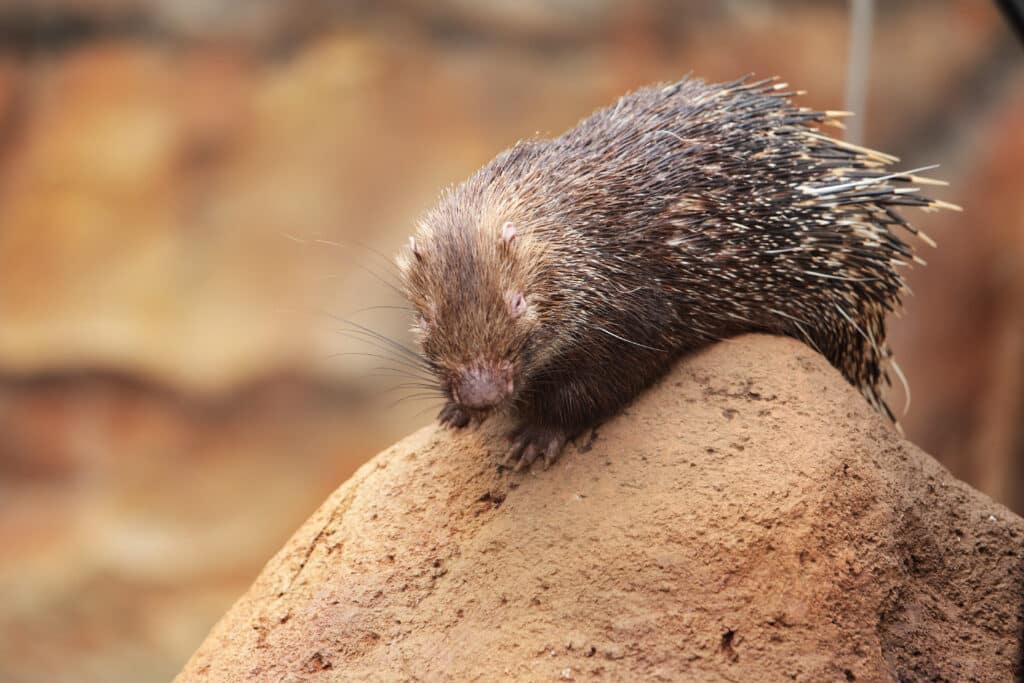
- The Palawan porcupine is considered an “Old World Porcupine,” meaning it only walks on the ground, while “New World Porcupines” also climb trees.
- No porcupines can shoot their quills; that is a myth! Instead, like a peacock, they will fan their quills out to create a sharp barrier between themselves and the predator.
- To stay safe from scavengers, they will dig deep burrows in the ground and live in their dens.
- Porcupines are a part of the rodent family. They are related to mice and capybara.
DIET | Herbivore – roots, tubers, bark, carrion, insects, vegetation, and fallen fruits
Prairie Dog (with video)
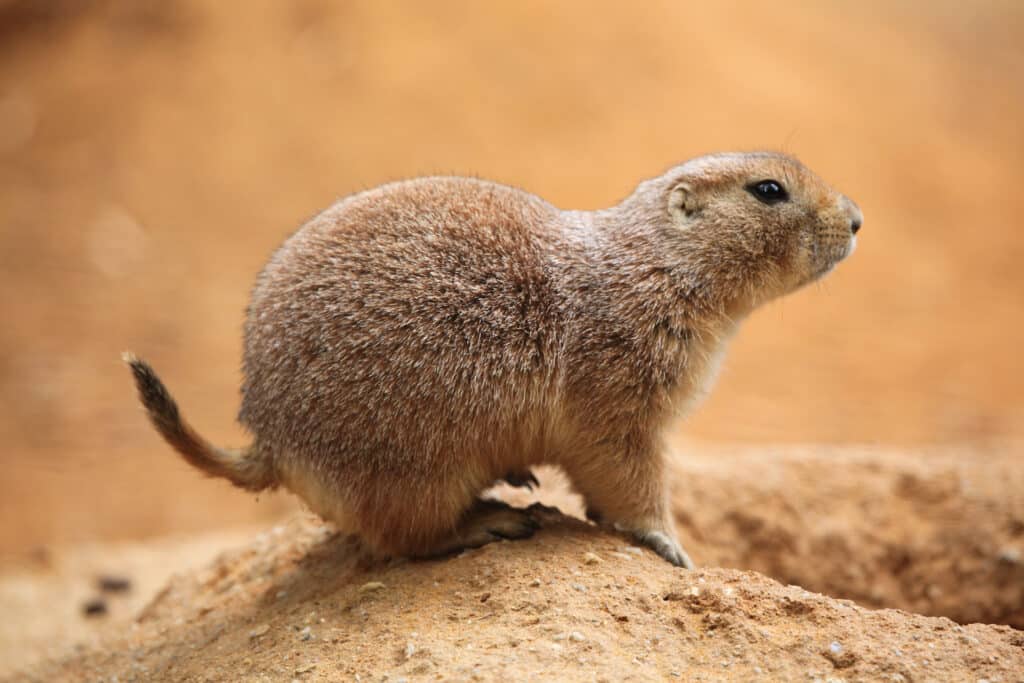
DIET | Herbivore – grasses, flowers, roots, seeds, and insects
- Prairie dogs are very communicative animals, known for their excited “yahoos,” where they jump up and cheer.
- Prairie dogs greet each other by “kissing.” They will go up to their friend and touch their teeth together.
- This animal is very social, living in an underground burrow called a prairie dog town.
- Coyotes, badgers, and eagles are their main predators.
Prehensile-tailed Porcupine
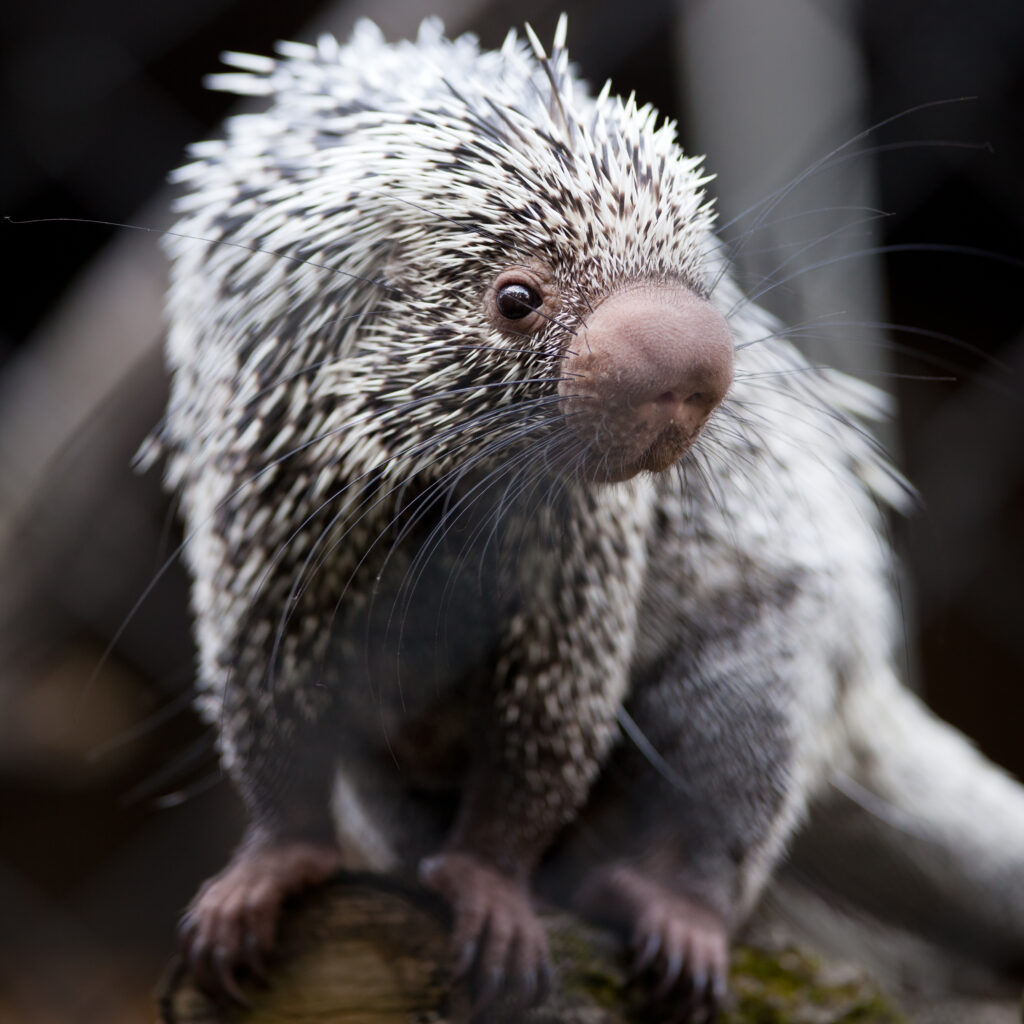
DIET | Herbivore – leaves, shoots, fruits, bark, roots, and buds.
- Using their prehensile tail and modified front and back feet to hold branches, this porcupine species spends most of its life in trees.
- They are known to move to a new tree each day.
- Like many nocturnal animals, this porcupine has poor eyesight but has keen senses of smell, hearing, and touch.
- They have no designated breeding season; they can breed year-round.
- Prehensile-tailed porcupines are monogamous.
Raccoon (with video)
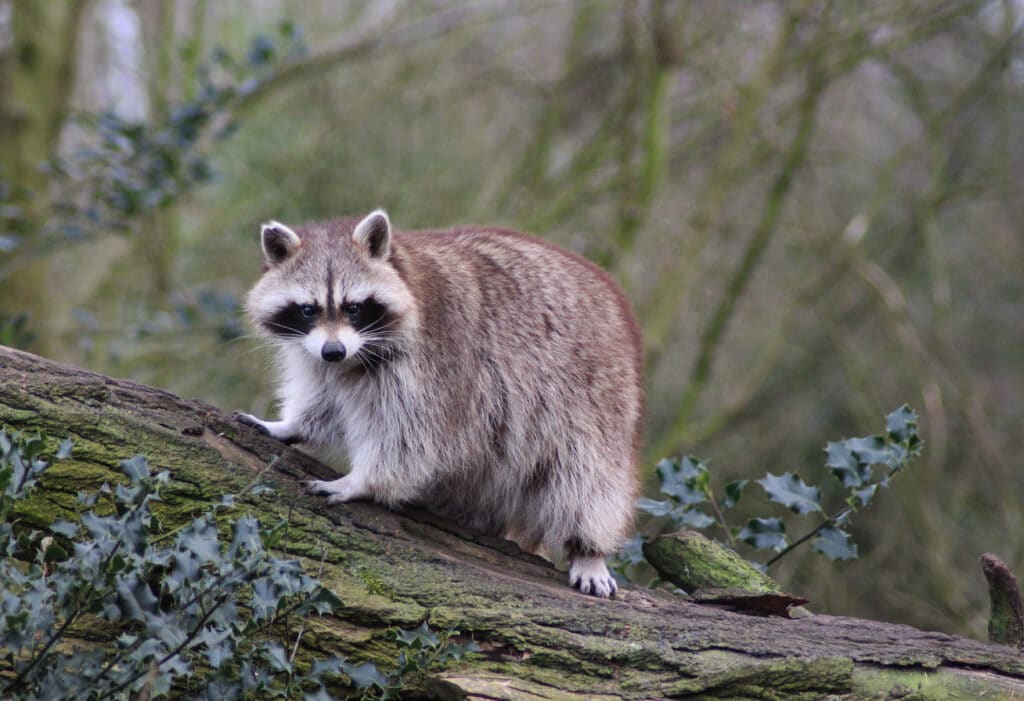
DIET | Omnivore – fleshy fruits, acorns, hickory nuts, grains, invertebrates, crayfish and insects, rodents, young rabbits, birds, turtles, eggs, and fish.
- The raccoon is in the Procyonidae family. They are related to the olingo, coatimundi, kinkajou, and ringtail cats.
- Raccoons have some of the most dextrous hands found in nature.
- They are among the few species of animals that have benefited from the rise in the human population.
- They are intelligent animals that can solve problems, work out complex puzzles, and remember the solution.
Red Fox (with video)
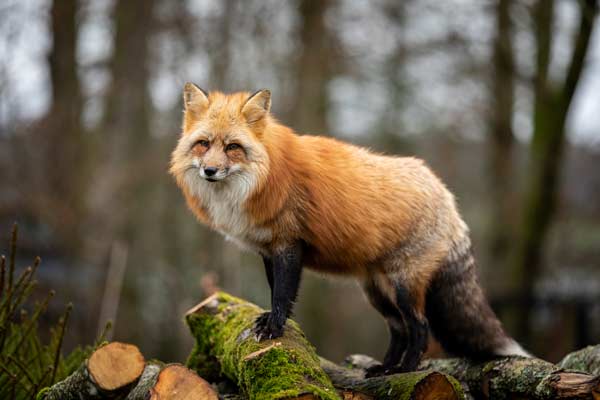
DIET | Omnivore – berries, fruit, rabbits, rodents, birds, frogs, and earthworms
- The red fox is a part of the Canidae Family. They are related to domestic dogs, wolves, and coyotes!
- They are very vocal animals. They utilize over 20 calls, ranging from yips to sounds like a human woman screaming.
- The red fox is monogamous. They will be with one mate for the entirety of their lives.
- They have excellent hearing. They can hear small rodents digging or a crow take flight a third of a mile away.
Red Kangaroo (with video)
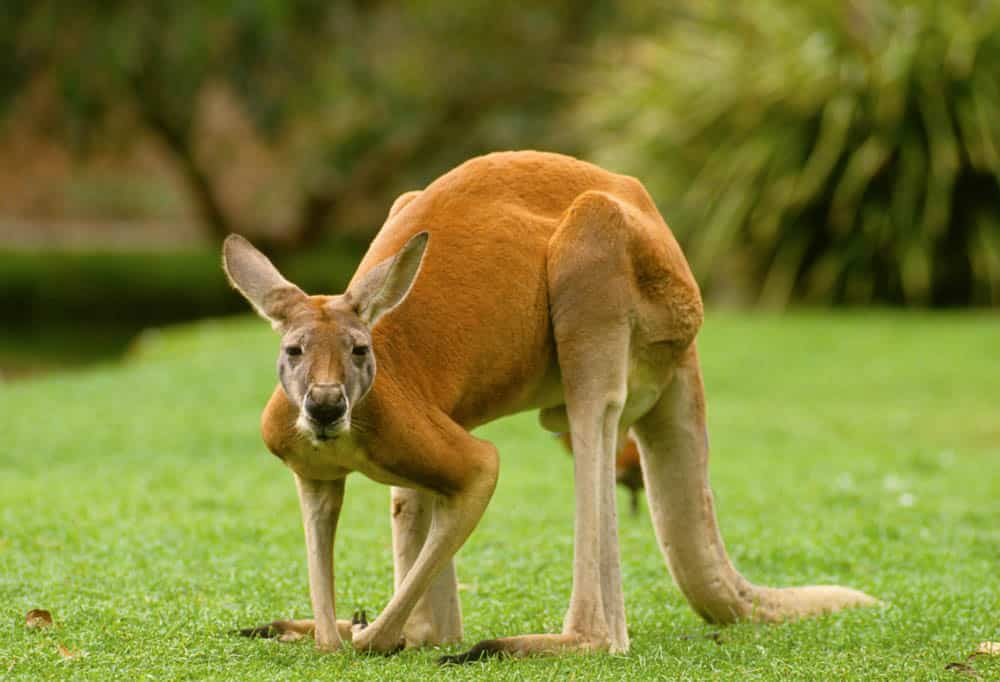
DIET | Herbivore – grass, flowers, roots, tubers, and vegetation
- The red kangaroo is a tripedal animal that relies on its large muscular tails to remain upright and walk around. Their tails help them keep their balance when jumping up to 25 feet.
- Only the size of a bumblebee when born, the blind kangaroo joey climbs all the way up into momma’s pouch, where it will live and grow for 6-9 months!
- A full-grown male kangaroo can reach up to 7 feet tall!
- A group of kangaroos is known as a mob.
Rex Rabbit (with video)
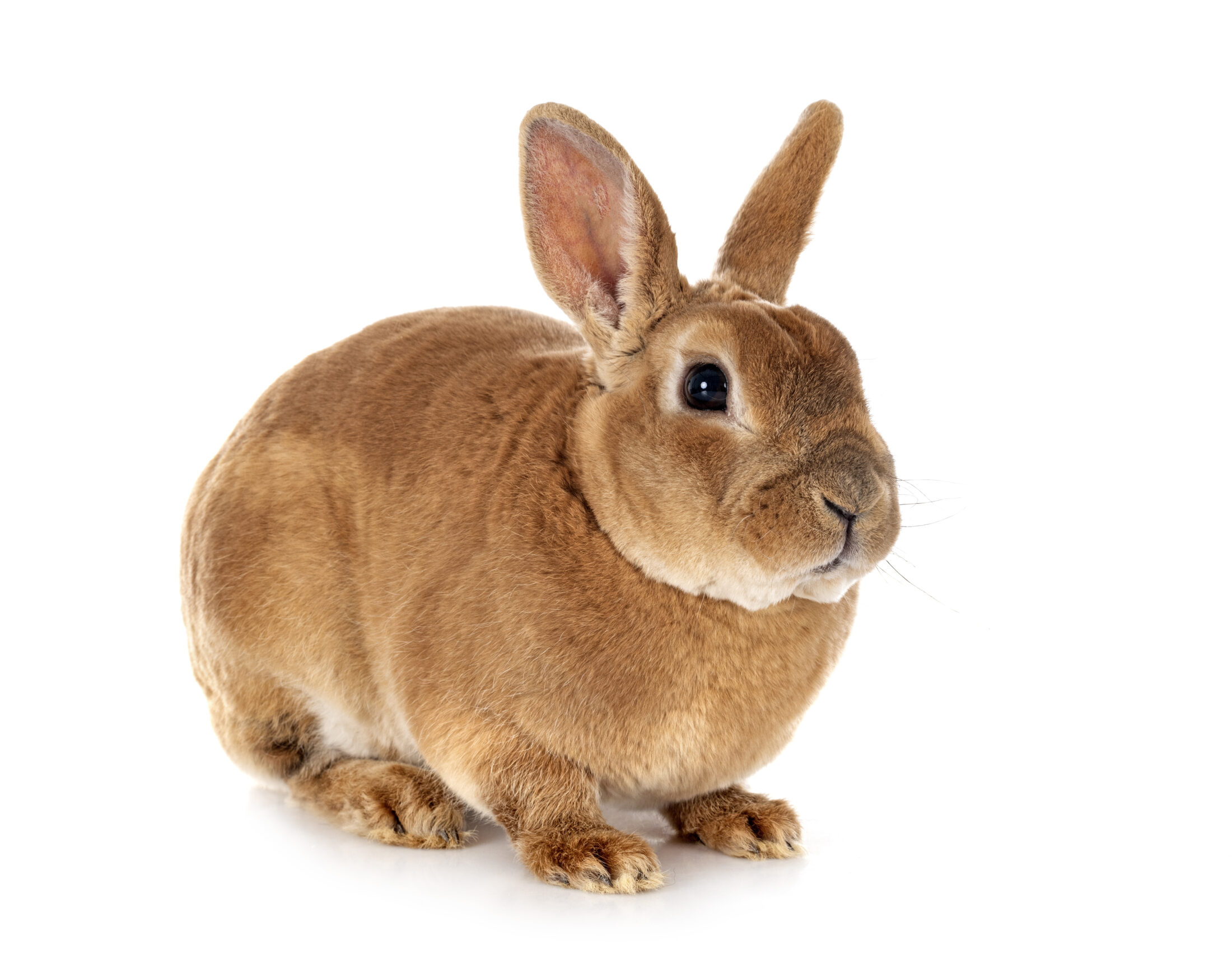
DIET | Herbivore – grass, flowers, and vegetation
- Known as “The King” of rabbits, the rex rabbit originated in France in 1919.
- Typically, rabbits have two layers of fur, one shorter and one longer outer protective layer.
- The rex rabbit’s fur is all the same length, creating an extra soft velvety feeling.
Ring-tailed Lemur (with video)
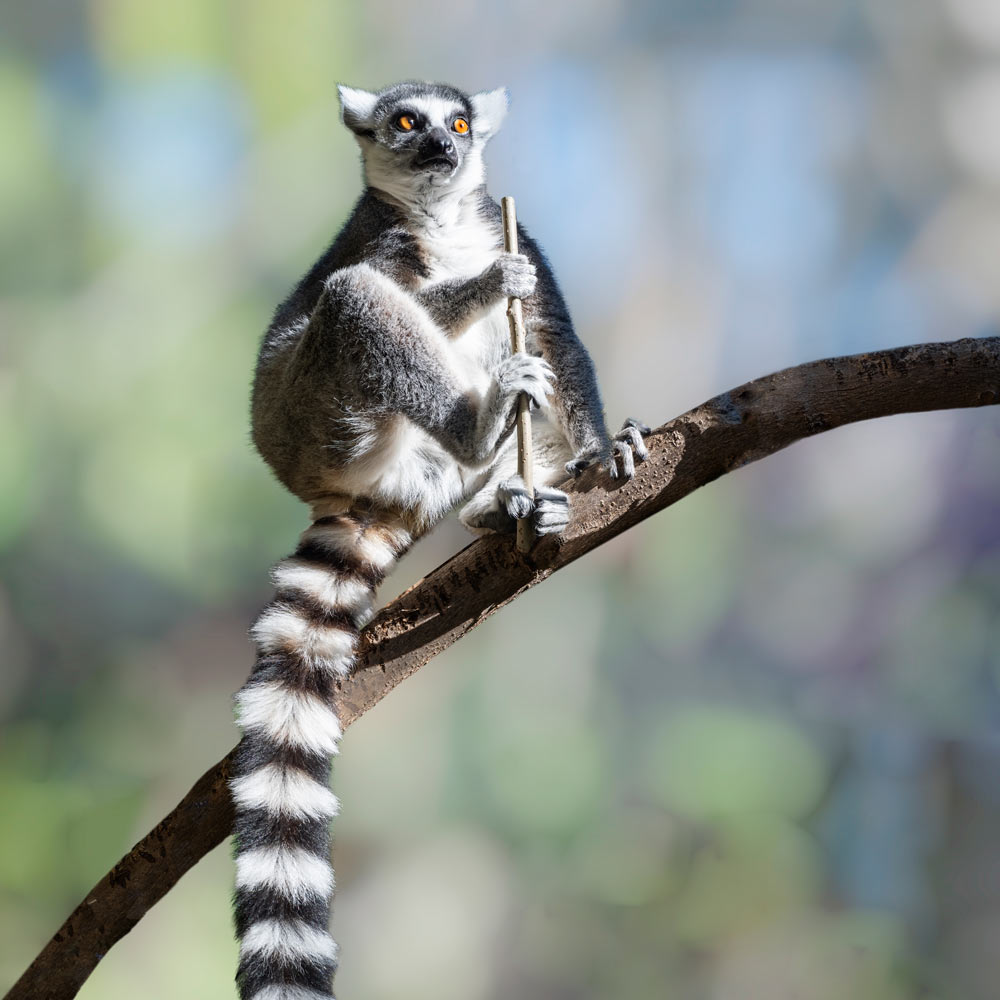
DIET | Omnivore – fruit, greens, bugs, and small invertebrates
- Lemurs are not monkeys. They are lesser primates.
- While most monkeys, like apes and capuchins, are greater primates.
- Lemurs are capable of over 20 distinct vocal calls. Lemurs are social animals that live in groups of three or more.
- Lemurs are from “matriarchies,” meaning their group leader is always female. The highest-ranked male will always be ranked lower than even the lowest-ranked female.
Rock Hyrax
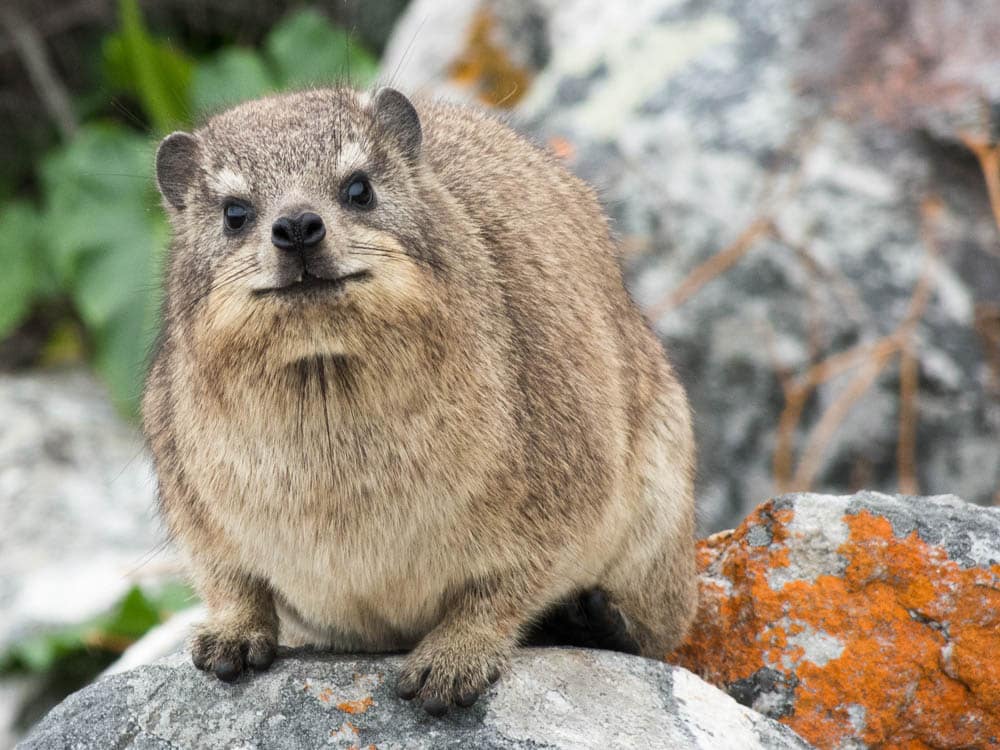
DIET | Herbivore – vegetation and grasses
- The rock hyrax is well adapted to mountainous environments and can climb rocks and cliffs swiftly.
- Their closest living relative is, surprisingly, the elephant!
- When alarmed, the hyrax will make a snarling bark-like sound to scare off predators.
- They are highly social animals that live in groups of 5–20 individuals. They are a very close-knit family grouping that fiercely protects their young.
Spotted Skunk
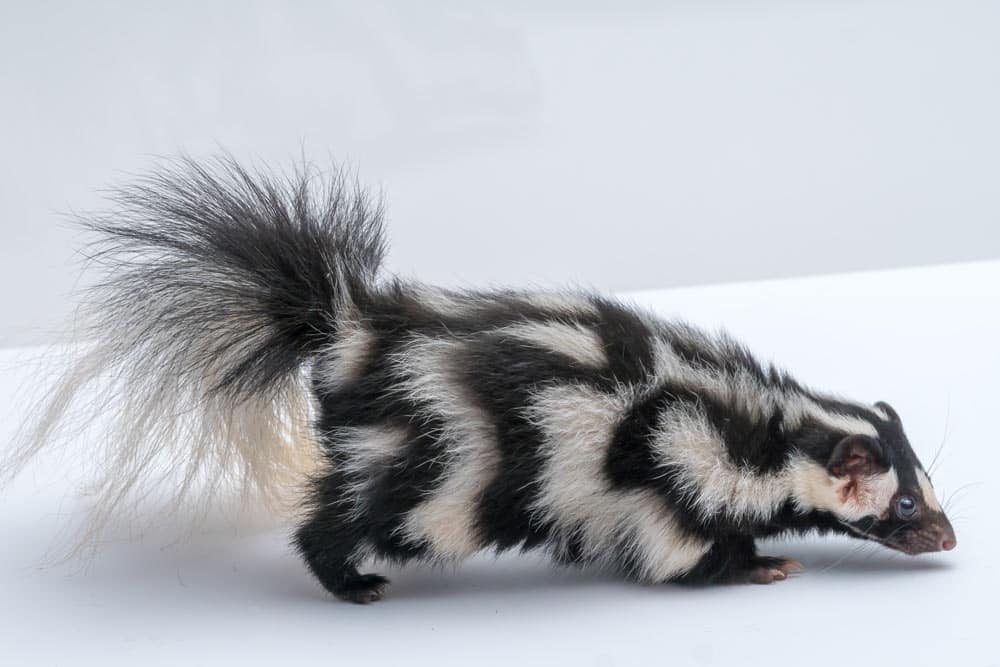
DIET | Omnivore – bugs, meat, vegetation, fallen fruits, and foraged human trash
- Skunks are nocturnal animals with a unique and well-known defense mechanism against predators: spraying.
- Skunks have a limited amount of spray in their body that needs time to replenish. They try to scare predators off by stomping their feet or kicking themselves into a handstand to reserve their spray.
- They are excellent diggers and will live in underground dens that they dig themselves.
- Skunks are immune to snake venom and bee stings.
Striped Skunk
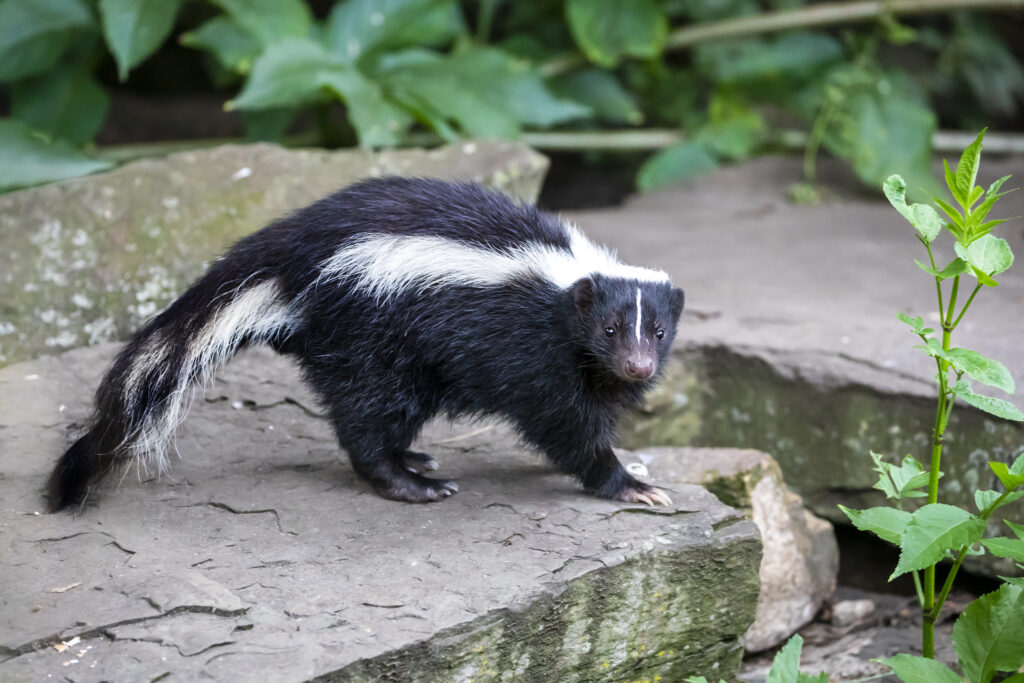
DIET | Omnivore – bugs, meat, vegetation, fallen fruits, and human trash
- Skunks are nocturnal animals with a unique and well-known defense mechanism against predators: spraying.
- Skunks have a limited amount of spray in their body that needs time to replenish. They try to scare predators off by stomping their feet or kicking themselves into a handstand to reserve their spray.
- They are excellent diggers and will live in underground dens that they dig themselves.
- Skunks are immune to snake venom and bee stings.
Sugar Glider (with video)
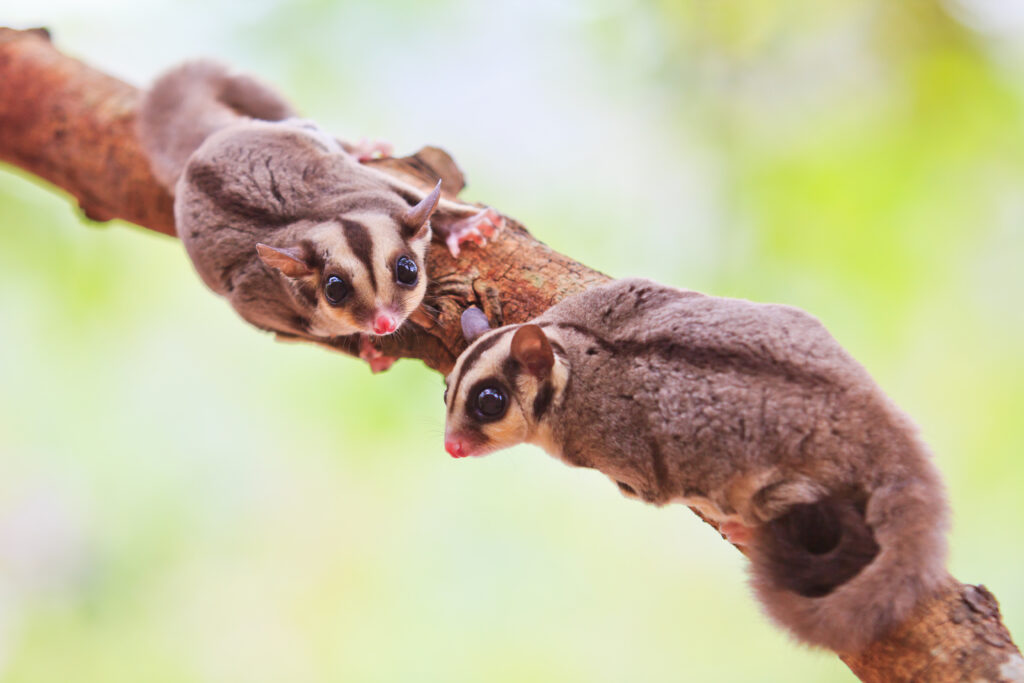
DIET | Omnivore – insects, small vertebrates, Eucalyptus tree, sap, nectar, pollen, and fruits.
- Sugar Gliders get their name from their love of sweet foods and a thin membrane under their arms that allows them to glide through the air.
- They are marsupials, which means they carry their babies in their pouch, just like the kangaroo.
- In the wild, they spend most of their life gliding through trees. They rarely land on the ground.
- They are very social animals. They prefer to live in prominent families of five or more individuals.
Tamandua Anteater (with video)
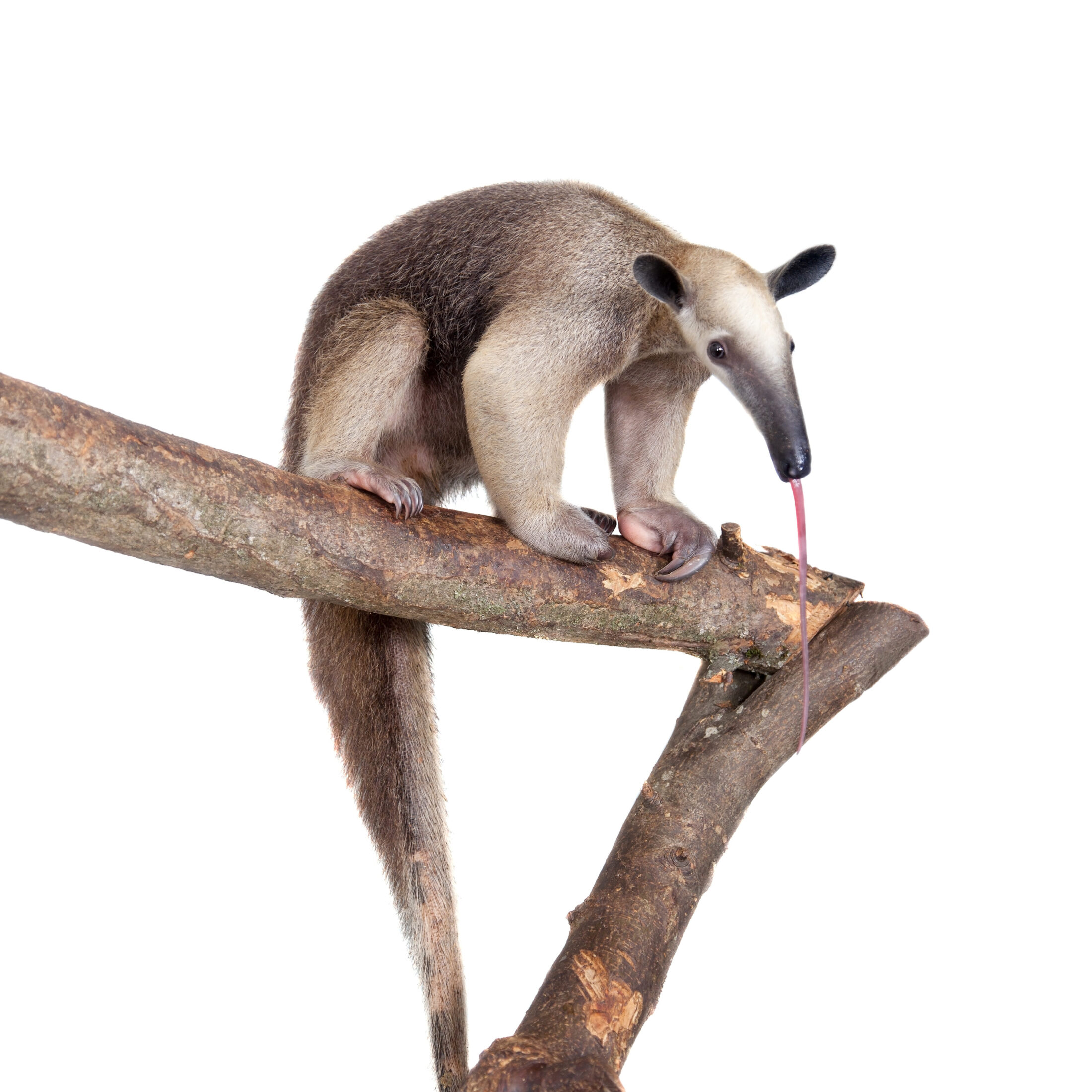
DIET | Carnivore – ants and termites
- The lesser tamandua is a slow-moving animal in the Myremecophagidae family, which means ant eater in Latin.
- Their body is unique. They have stiff, leathery skin, exceptionally long claws, a prehensile tail, and a long, skinny tongue.
- They use their strong claws to break into things like termite mounds and old logs to find food. Their long tongue can scoop up tiny bugs.
- They are primarily arboreal animals, meaning they spend most of their time in trees.
Tayra
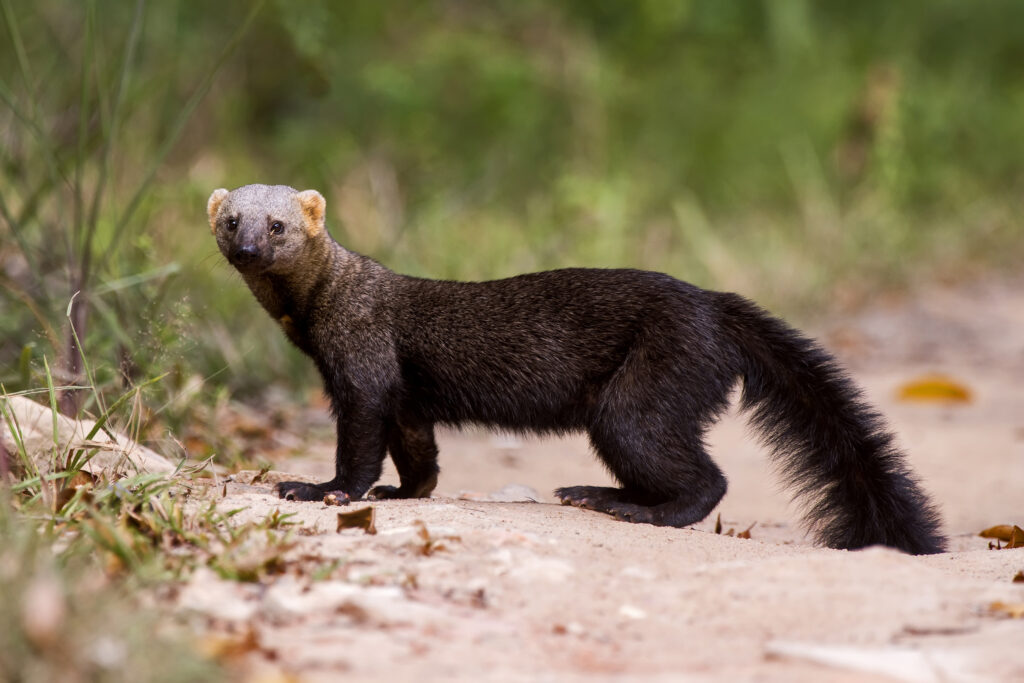
DIET | Omnivores – small prey, fruits, vegetation, bugs, and fish
- Tayras are a part of the Mustelidae family, related to weasels, otters, badgers, and wolverines.
- They are swift animals. They can run, climb, and swim with agility and speed.
- They are mainly nocturnal animals.
- They are very playful animals but do not get along well with others.
- Tayras live in hollow trees, burrows, and small nests.
Tenrec (with video)
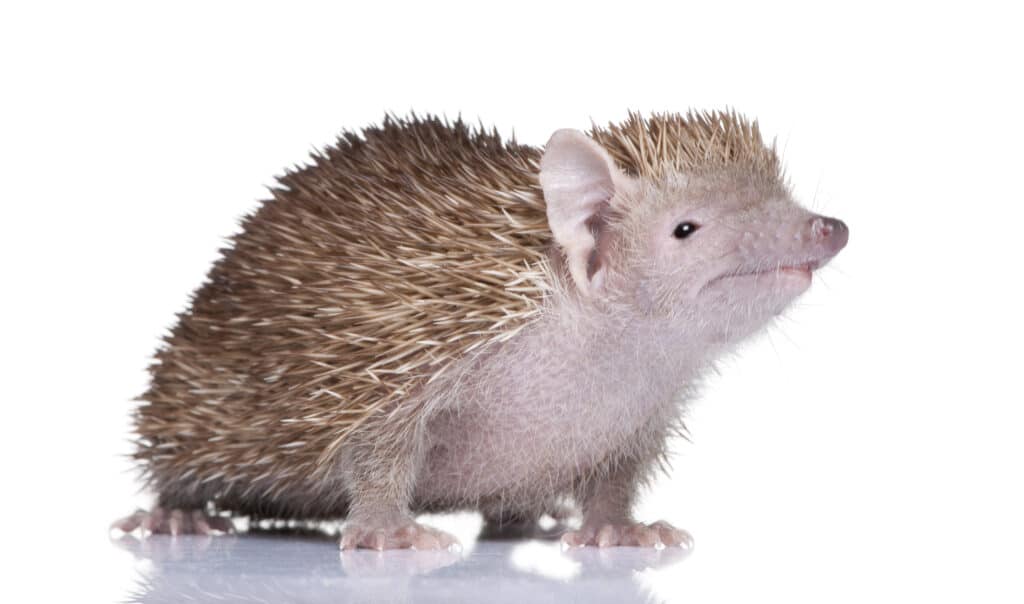
DIET | Omnivore – insects and vegetation
- Despite its name and appearance, the lesser hedgehog tenrec is unrelated to the hedgehog. It is more closely related to the elephant than its prickly doppelganger.
- Tenrecs are nocturnal and very shy. They hide in their nests or underground burrows during the day.
- For protection from predators, they may roll into a ball or dig themselves into the ground to escape from view.
- Tenrecs may have up to 32 offspring in a single litter.
Thomson’s gazelle
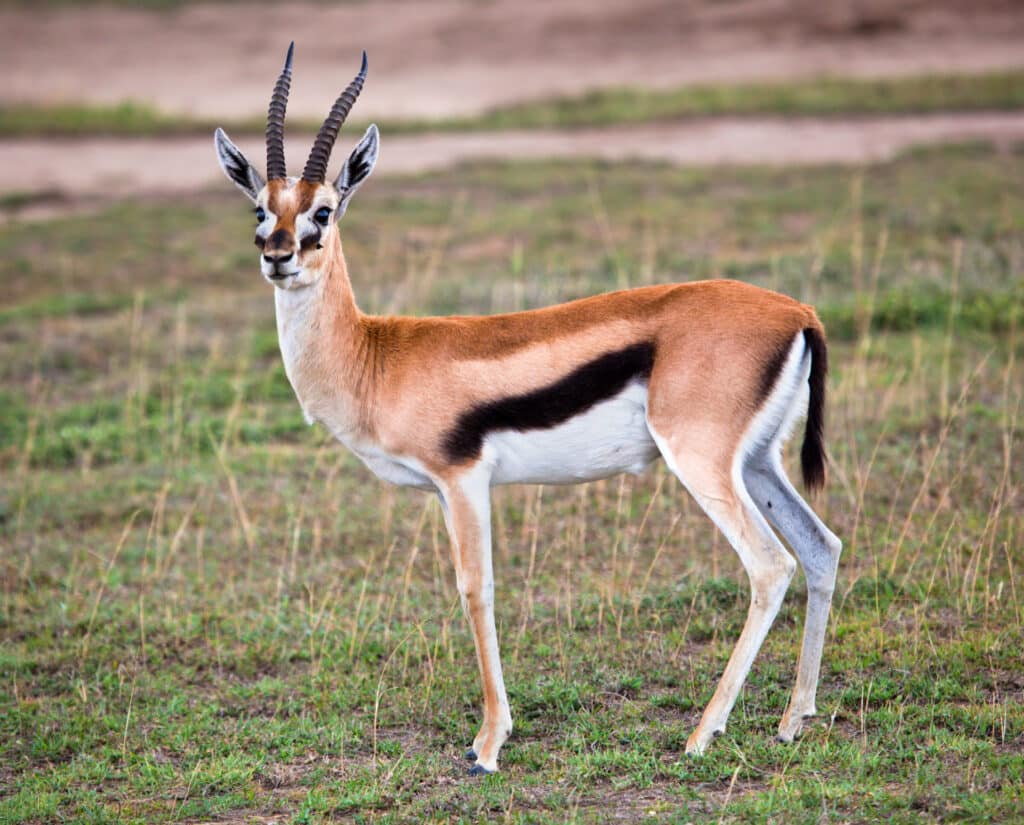
DIET | Herbivore – grasses, shrubs, and seeds
- This animal has exceptionally keen senses and is always on high alert for predators, often fleeing at the slightest sign of danger.
- They travel in small herds that help protect individuals from predators. Predators of the Thomson Gazelle include wild dogs, leopards, cheetahs, hyenas, jackals, and lions.
- Thomson Gazelles are found in the grasslands and deserts of eastern Africa.
Two-toed Sloth
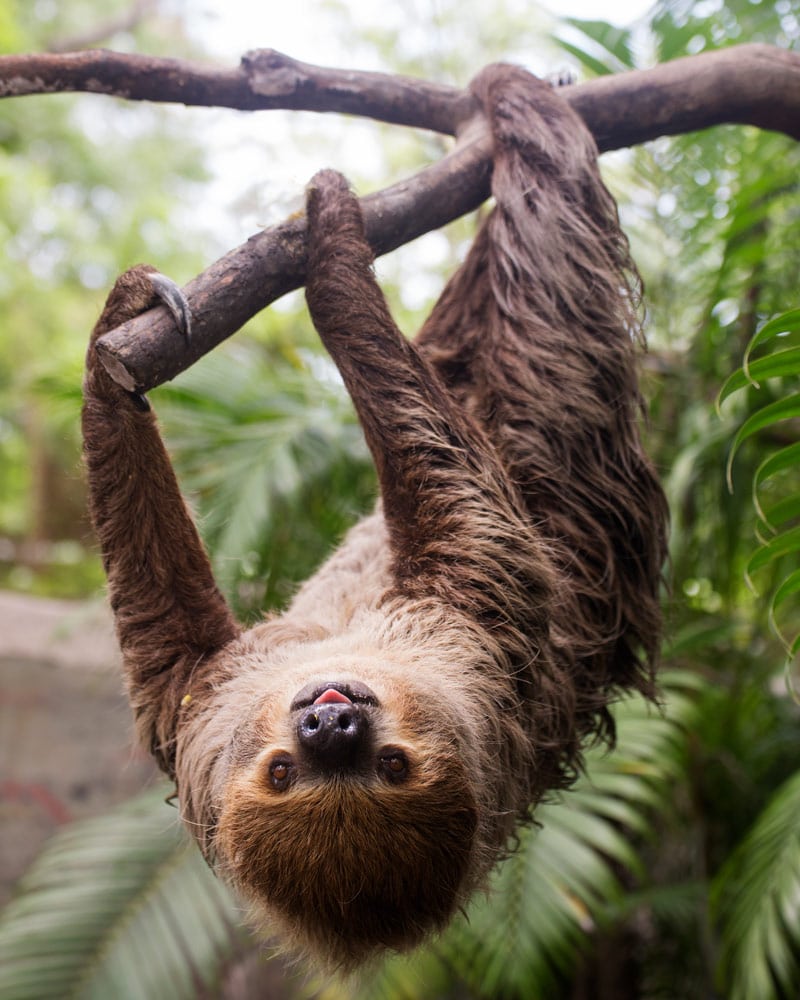
DIET | Herbivore – greens and vegetation
- The sloth is a slow-moving animal in the Xenarthra family, so they are related to armadillos and anteaters.
- Sloths are surprisingly good swimmers. They can drop into the water and swim to a new home territory.
- It can take a sloth 30 days to digest a leaf! On average, it takes them two weeks to digest food.
Virginia Opossum (with video)
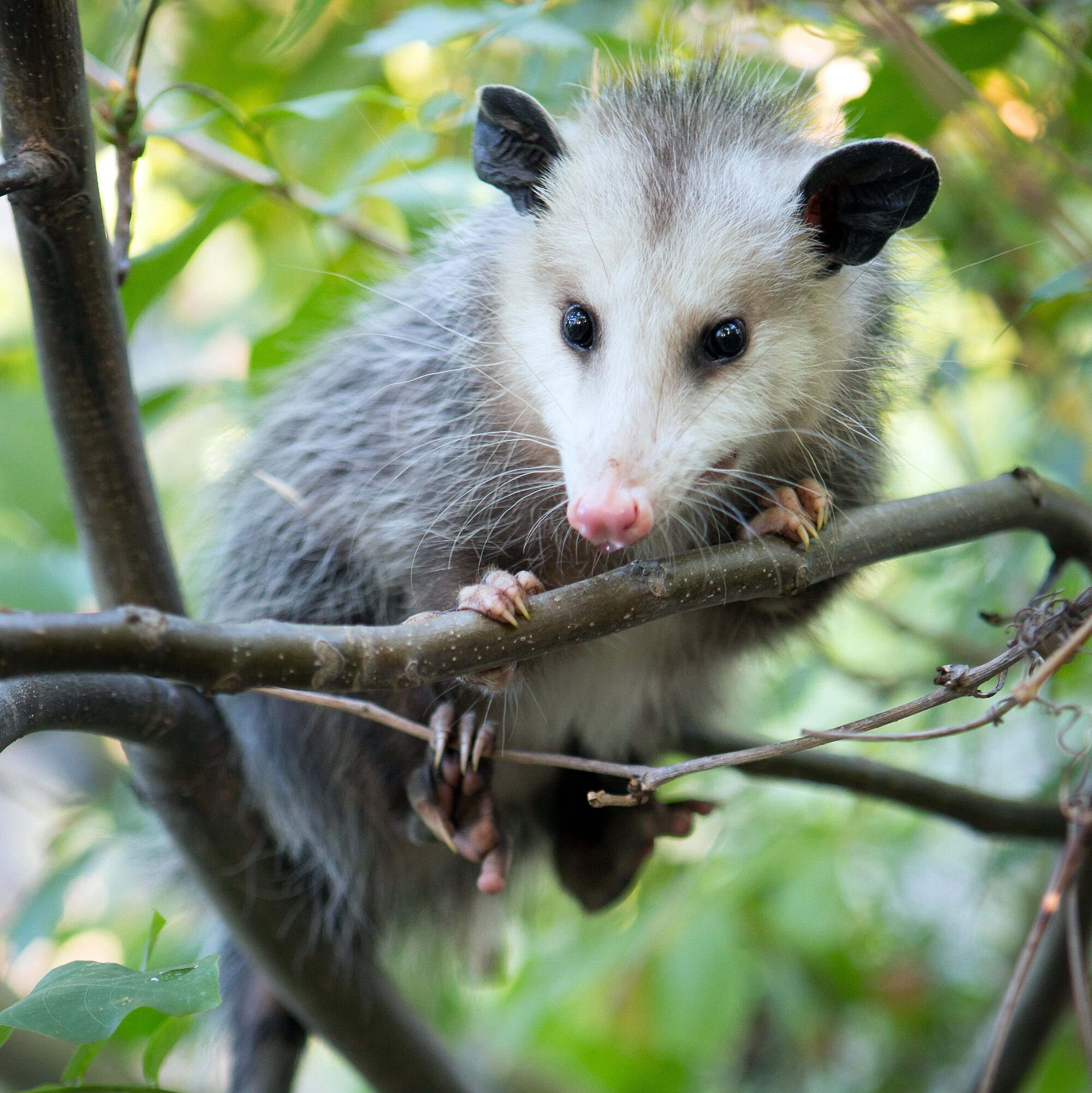
DIET | Omnivore – small mammals, birds, insects, worms, ticks, vegetation, fruits, and seeds
- The Virginia opossum is North America’s only marsupial. They have 10-14 bumblebee-sized babies that crawl into their pouch after birth.
- They are immune to rattlesnake venom! They can withstand venom of up to 70 bites. They can do this because of peptides in their blood.
- They have more teeth than any North American mammal!
- Opossums are nocturnal. They will sleep during the day and come out at night to feed on any slow-moving prey they can find.
Wallaby (with video)
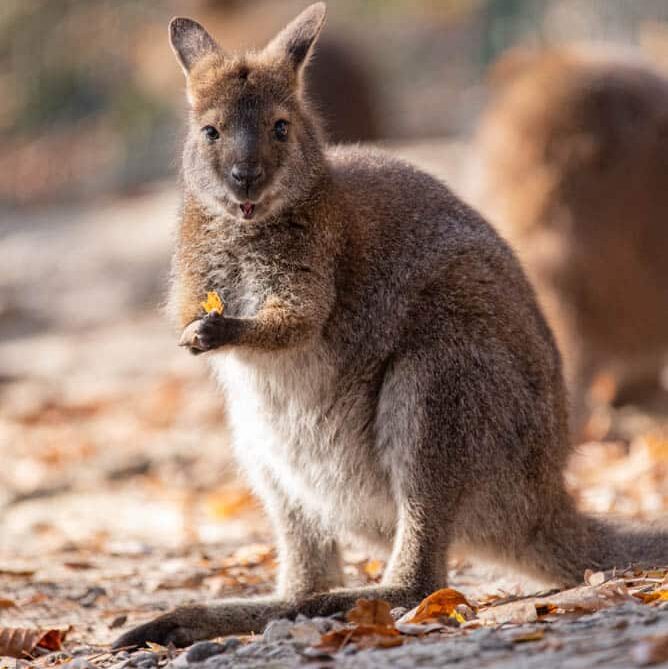
DIET | Herbivore – vegetation, grass, and roots
- The Bennett wallaby, also known as the red-necked wallaby, is in the macropod family, so they are related to kangaroos, tree kangaroos, and quokkas.
- Wallabies and kangaroos are marsupials. So when their bumblebee-sized joeys are born, they crawl into the momma’s pouch, where they do the rest of their development.
- They are most active at dawn and dusk to avoid the midday heat.
- They are solitary but not territorial animals, bounding away at the first sign of danger.
Woodchuck (Groundhog)
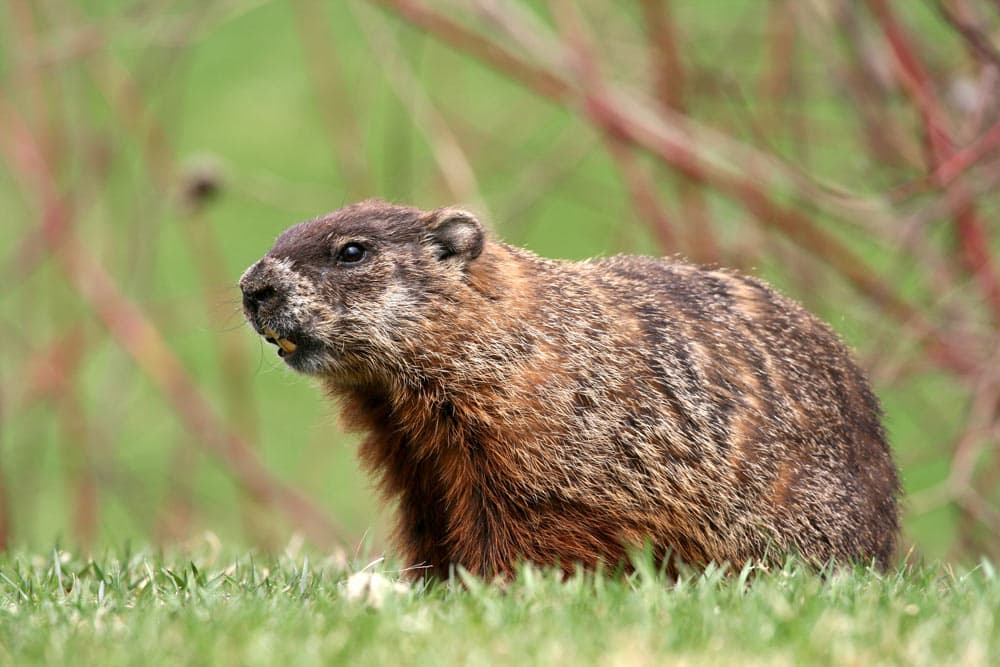
DIET | Herbivore – vegetation, fruits, grasses, and flowers
- The groundhog, or the Woodchuck or Whistle-pig, is in the rodent family. They get their alternative name, “Whistle-pig,” from the high-pitched call they use to alert their colonies of any danger.
- They spend their springs, summers, and falls gorging on food to prepare for winter. Then, they hibernate until the spring or until Groundhog Day.
- Groundhogs have a holiday named after them; according to tradition, if a groundhog sees its shadow on February 2nd, you can expect six more weeks of winter.
White-tailed Deer (with video)
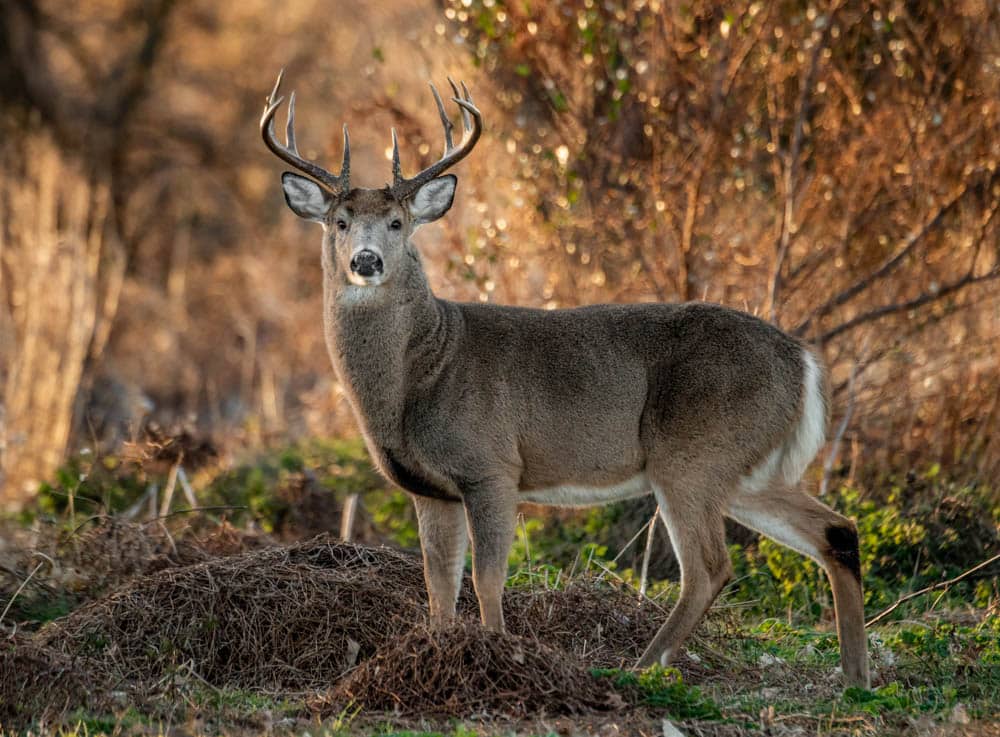
- DIET | Herbivore – fruits, berries, greens, nuts, acorns, and crops
- White-tailed Deer have 297 million olfactory (smell) receptors. A dog only has 5 million. They can smell up to 1,320 feet away!
- Male white-tailed deer grow and shed their antlers annually. The largest deers drop their antlers sooner, but generally, they start dropping them in January.
- This deer species can be found from Southern Canada to South America. They live in meadows and coniferous forests where they can find shade.
Mammals coming soon:
- Kunekune Pig
- Mangalica Pig
- Muskrat
- Prevost’s Squirrel
- Red Squirrel (Eastern)
- Richardson’s Ground Squirrel
- Sunda Porcupine
Reptiles & Amphibians
Ackie monitor lizard
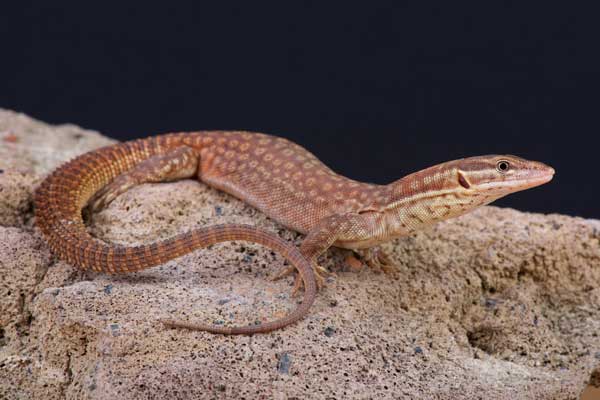
DIET | Carnivore – arthropods, insects, small lizards, mammals, eggs, and marsupial joeys.
- Also known as the spiny-tailed monitors, these lizards use their spiny tails to protect themselves from predators. They wedge themselves into a tight space and block the entrance with their tail.
- Monitor lizards are known to be especially complex and intelligent reptiles.
- This subspecies of spiny-tailed monitor has the longest tail and legs of the subspecies.
- In the wild, approximately 70% of its water requirement comes from food.
American alligator (with video)
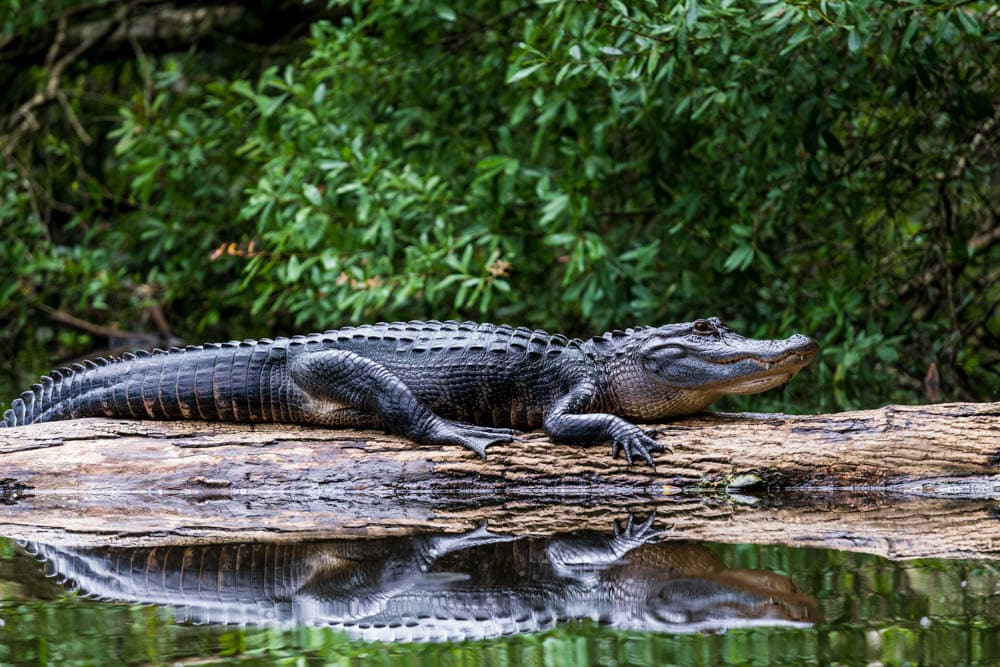
DIET | Carnivore – They eat anything that falls in the water, whether fruit from trees or unlucky animals.
- The alligator conserves energy by lazing around for days before it eats. It typically will not actively seek out prey.
- Alligators spend the majority of their days on the floors of river beds. Full-grown alligators can hold their breath for up to eight hours!
- When full-grown, gators have a bite force of 2120+ PSI. They also have the second most substantial bite, second to the crocodile.
- Alligators can go through more than 2,000 teeth in their lifetime!
American toad
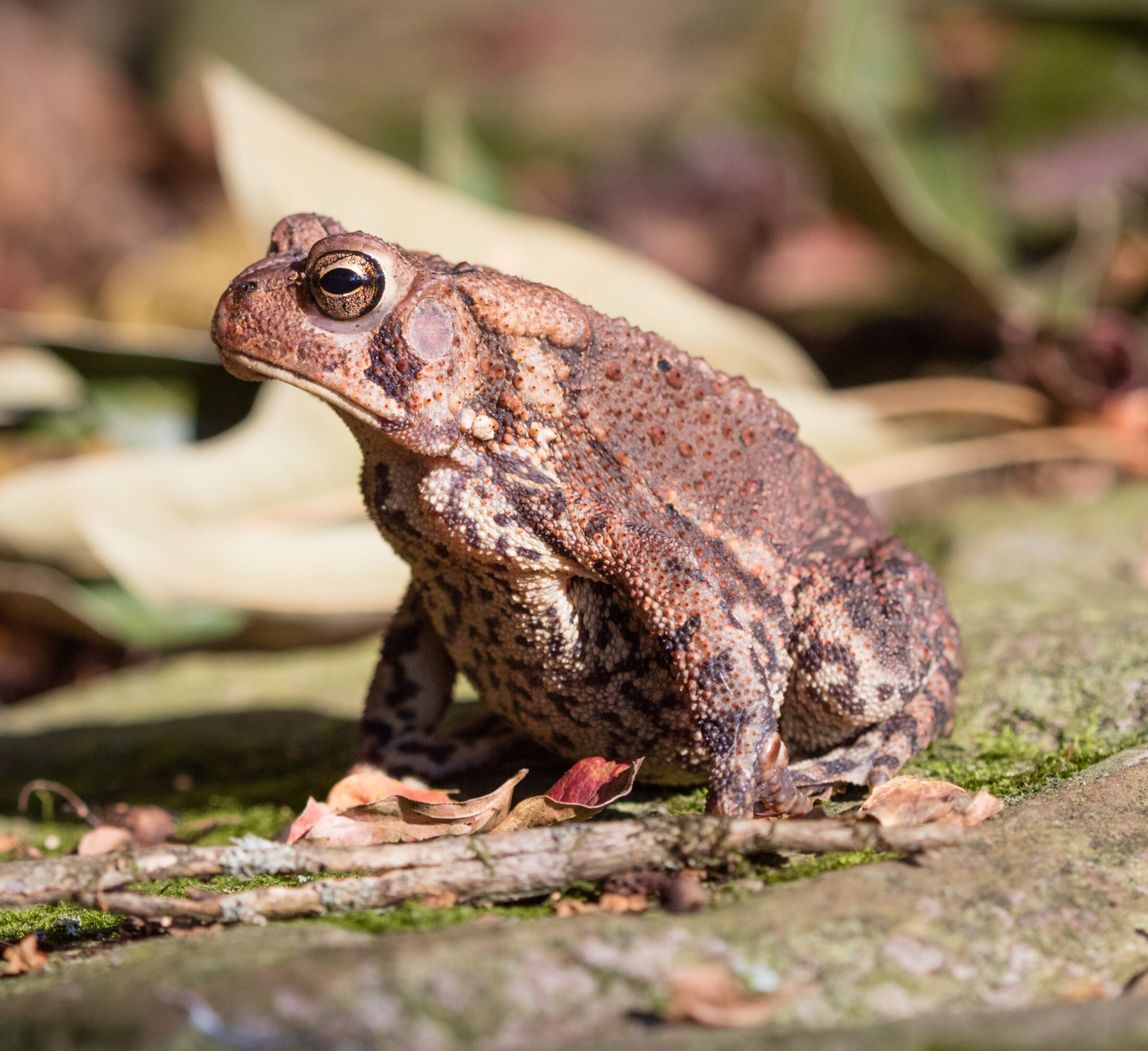
DIET | Carnivore – insects, spiders, earthworms, slugs, and other invertebrates.
- Toads do not drink water. They absorb it through their skin.
- Females lay spiral strands of 4,000 to 8,000 eggs that hatch in about a week.
- American toads are the most widespread toad species in North America.
- Contrary to folk tales, you will not get warts if you touch a toad. However, the defensive chemicals in toad skin are toxic to humans, so washing one’s hands carefully after handling one is important.
Australian green tree frog
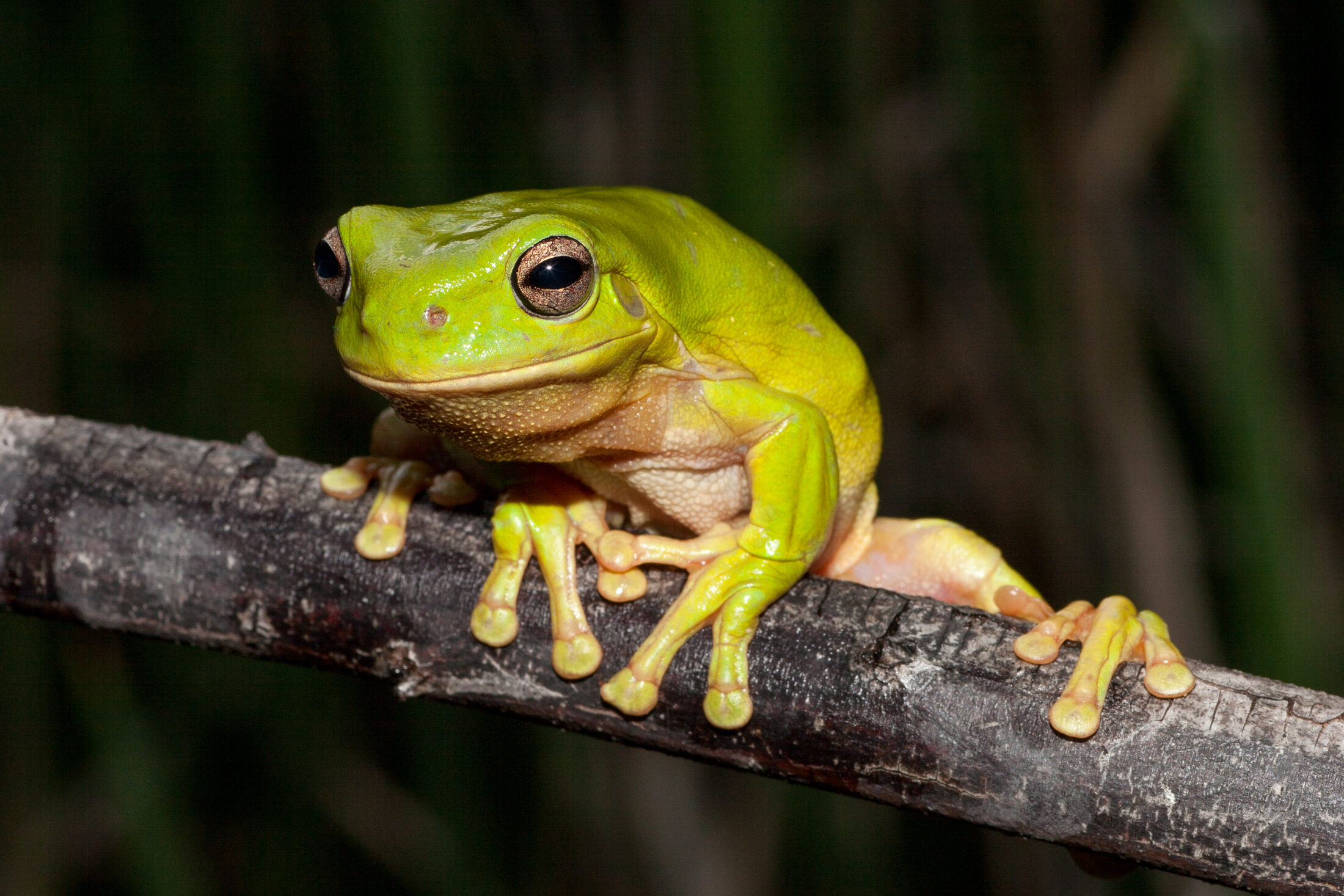
DIET | Carnivore – insects such as moths, cockroaches, and locusts. They also eat spiders and can include smaller frogs and even small mammals (including bats) among their prey.
- The Australian Green tree frog is also known as the Green tree frog, White’s tree frog, or the Dumpy tree frog.
- These frogs have enormous sticky toe pads with partial webbed toes.
- Their toes rely on wet adhesion, which is aided by the secretion of mucus.
- Docile and well suited to living near human dwellings, Australian green tree frogs are often found on window sills or inside houses, eating insects drawn by the light.
Ball python
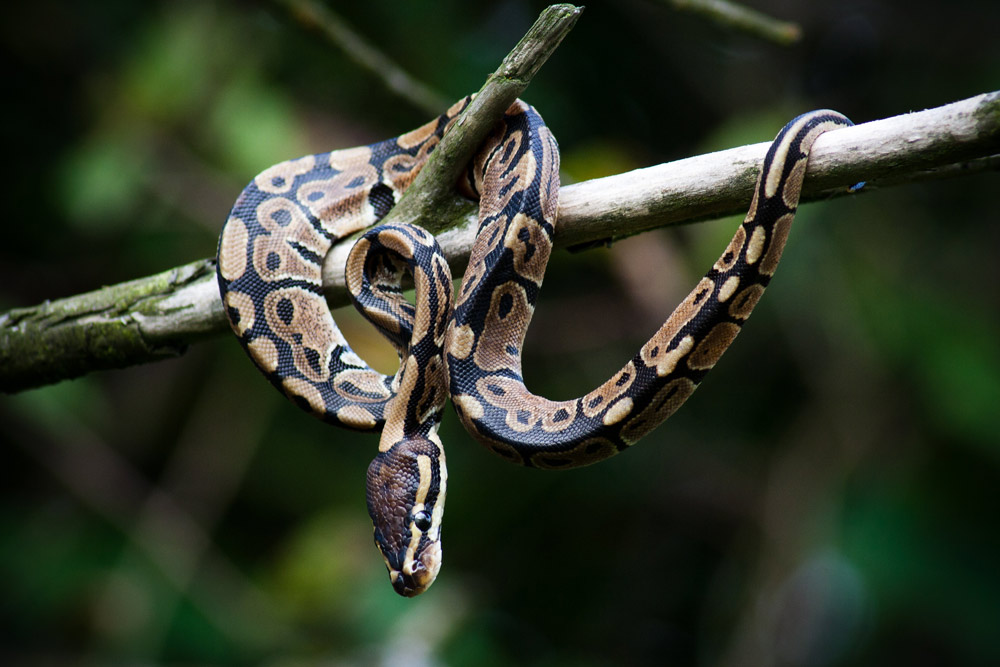
DIET | Carnivore – small mammals, birds, amphibians, and fish
- Ball pythons are non-venomous constrictor snakes.
- These snakes have an average of seven eggs per clutch.
- The mother protects the eggs before hatching. Once the hatchlings emerge, the mother will leave, and they live a solitary life, only meeting to mate.
Bell’s hinge-back tortoise
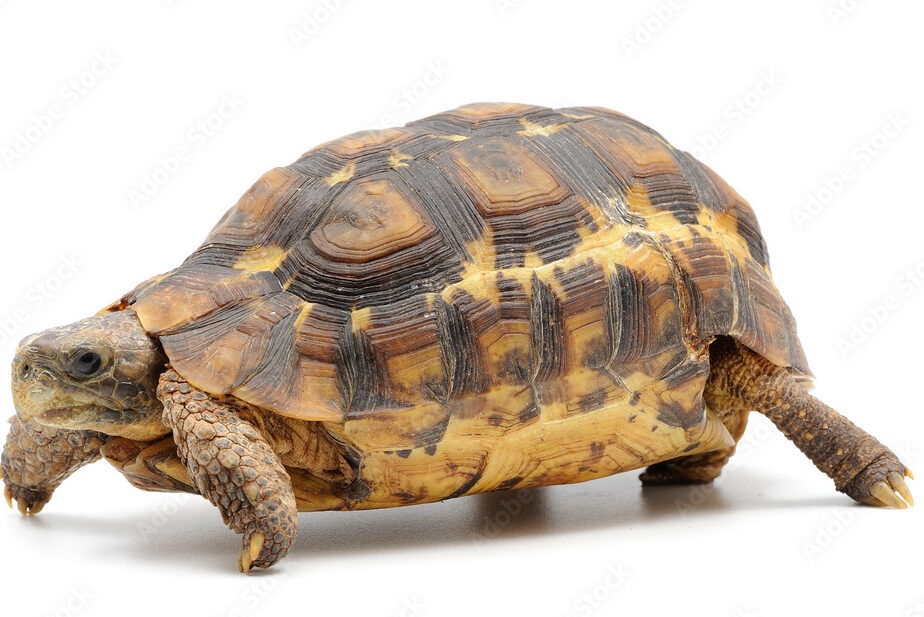
DIET | Omnivore – vegetables, twigs, roots, leaves, fruits, earthworms, snails, tadpoles, and other small invertebrates
- The ability to clamp down the rear portion of their shell to protect their vulnerable tail and back legs is how they earned the name hinge-back. When threatened, this tortoise can also partially retract its head into its shell and cover the opening with its front legs, which are protected by large scales.
- It can store water in anal sacs to help it survive dry periods.
Blue-tongued skink
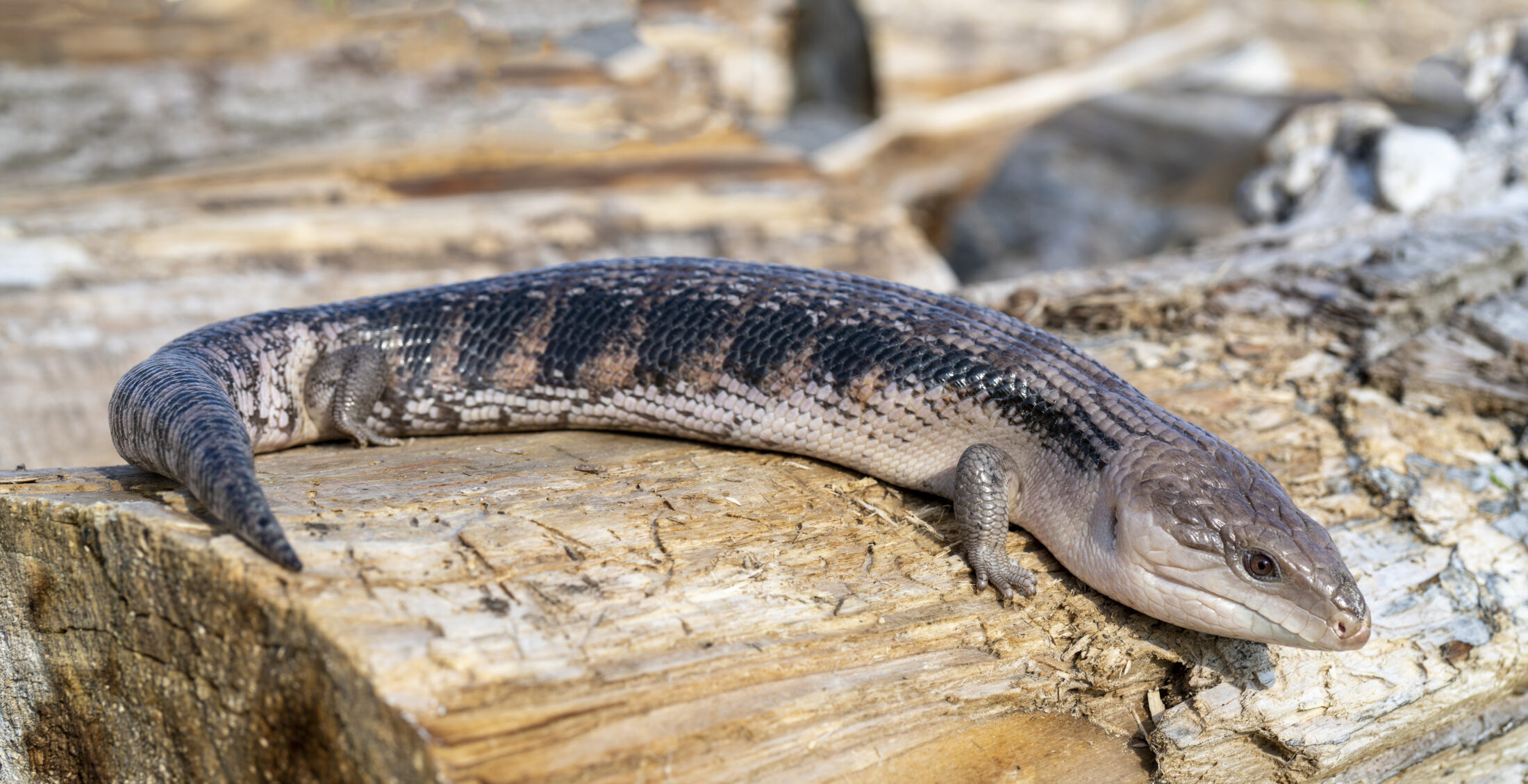
DIET | Omnivore – insects, other reptiles, plant material, and fruits.
- The blue-tongued skink is the largest member of the skink family.
- It uses its bright blue tongue as a defense mechanism. When threatened, it puffs up its body and opens its mouth to display its tongue and hisses.
- Blue-tongued skinks spend the majority of their day searching the ground for food and basking in the sun. At night, they seek shelter in logs, leaf litter, or other ground debris.
- Blue-tongued skinks are solitary lizards that only meet in the spring or winter to breed. Males will pursue females.
Club-tailed iguana
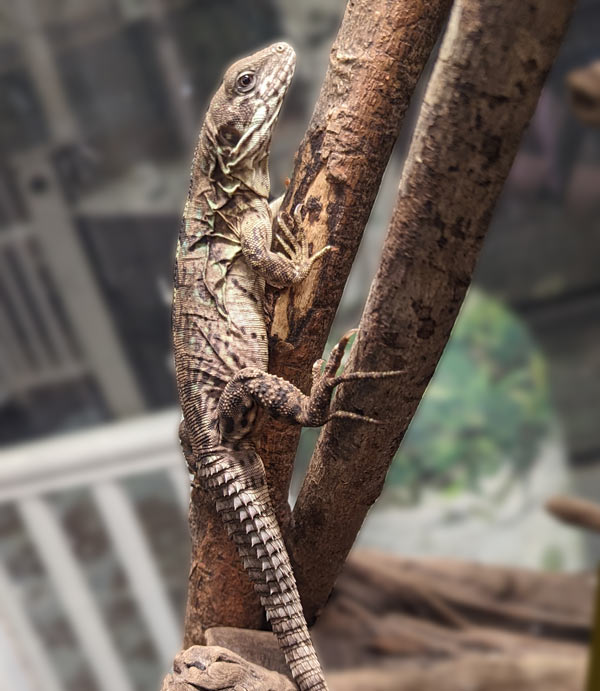
DIET | Omnivore – vegetables, twigs, roots, leaves, fruits, earthworms, snails, tadpoles, and other small invertebrates
- This species of iguana is the smallest in its animal family, Iguanidae.
- These iguanas are primarily arboreal, hiding in hollow logs, branches, and rock crevices.
- The tail of this species is heavily armored, with five rings of spines forming longitudinal ridges.
- If they are in danger from predators, they will enter a crevasse between rocks, inflate their bodies, and navigate their spiny tails to cover the opening to protect themselves from harm.
Columbian red-tailed boa
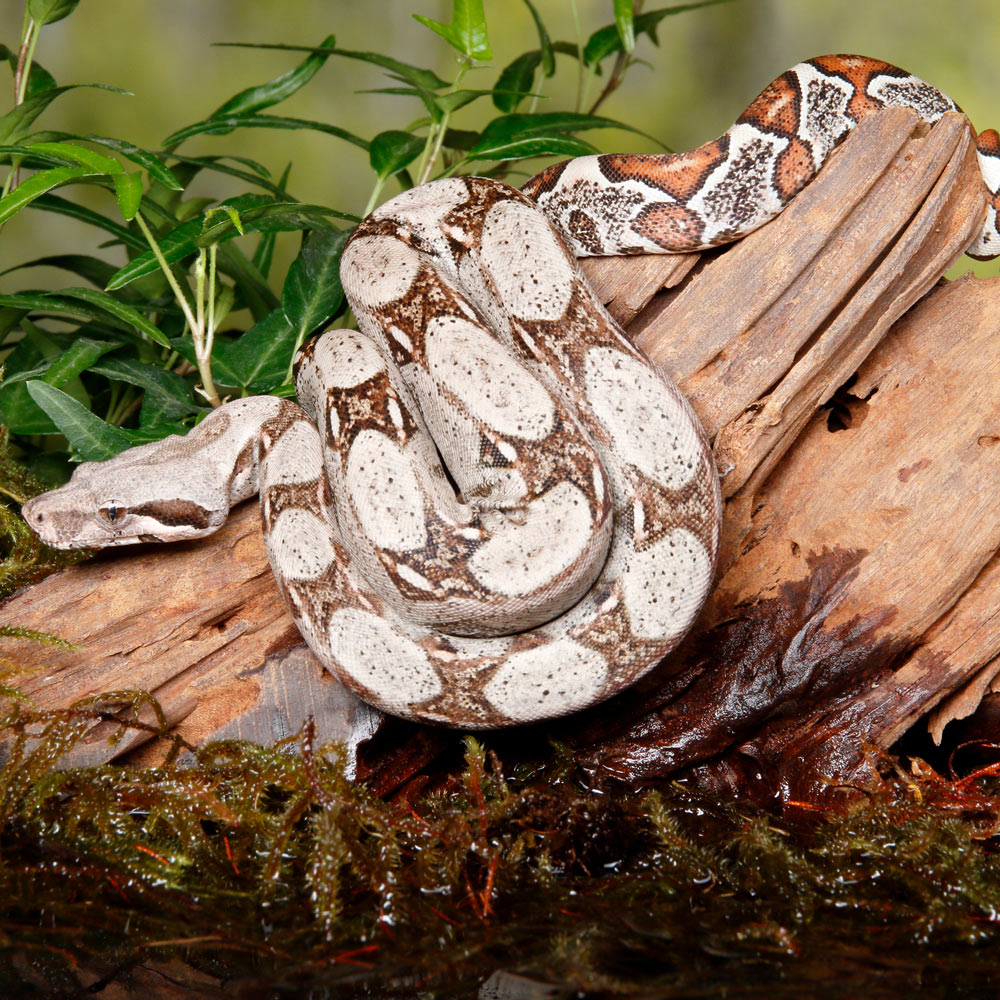
DIET | Carnivore – small to medium-sized mammals, birds, lizards, and amphibians
- Red-tailed boas are non-venomous constrictor snakes.
- These snakes do not lay eggs; they give live birth. Females incubate the eggs inside their bodies.
- After hatching inside the mother, she will give birth to up to 60 hatchlings.
Corn snake
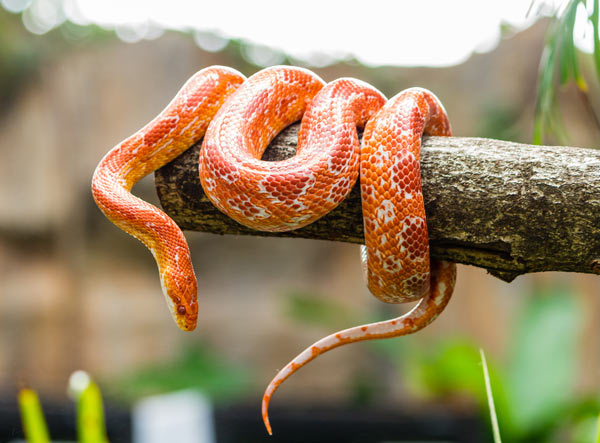
DIET | Carnivore – small mammals, birds, lizards, and amphibians
- The corn snake is beneficial to humans because it helps to control populations of wild rodent pests that damage crops and spread disease.
- Though superficially resembling the venomous copperhead (Agkistrodon contortrix) and often killed as a result of this mistaken identity, the corn snake lacks functional venom and is harmless.
- The corn snake can be distinguished from other rat snakes and from kingsnakes by the stripe extending from the back of its eye past the corner of its jaw, plus the large, bold black and white checkerboard pattern on its belly.
- They are “solar-powered” and rely fully on external heat or light sources.
- They smell with their tongues.
Cuvier’s dwarf caiman
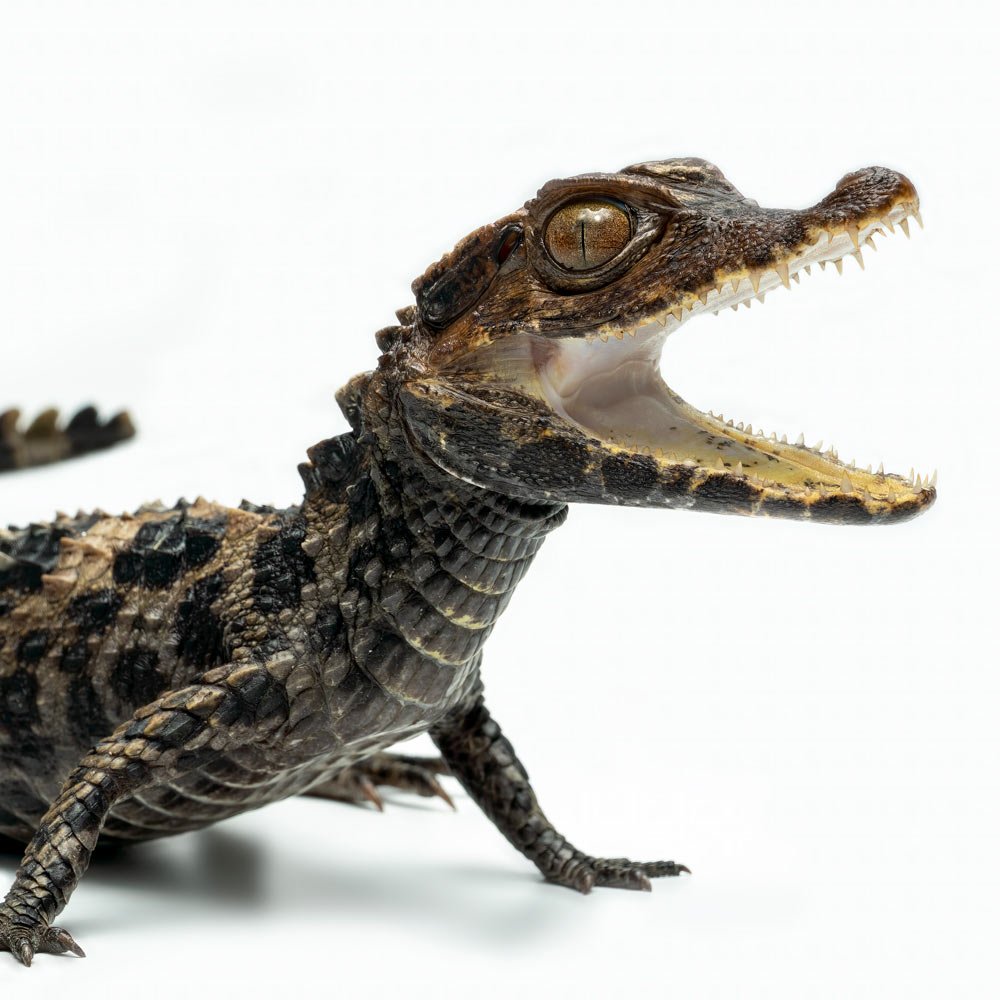
DIET | Carnivore – fish, amphibians, small mammals, birds, crabs, shrimp, mollusks, and other invertebrates
- Dwarf caiman are the smallest crocodilian species.
- Adult caiman are found alone or in pairs.
- They communicate and identify one another through sounds, movements, stances, smells, and touch.
Desert rosy boa

DIET | Carnivore – rodents, other small mammals, and small birds.
- The rosy boa is non-venomous.
- The desert rosy boa spends most of its life concealed beneath rocks and crevices to escape the elements and natural predators. Granite outcroppings are the most common geologic association inhabited by the desert rosy boa. Less often, it is associated with volcanic or other rock types.
- If hiding from a predator is not an option, it will try to confuse the adversary by making its tail appear to be its head. The boa will curl into a ball with its head in the center and wave its tail back and forth to look like a snake head ready to strike.
Florida softshell turtle
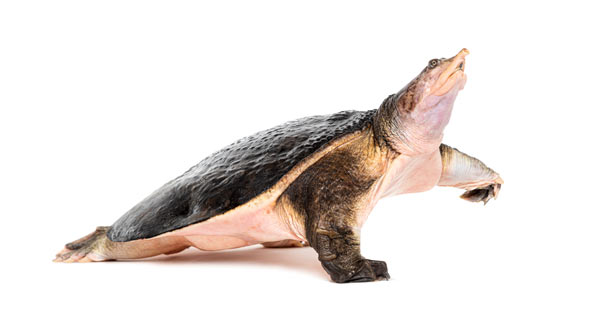
DIET | Carnivore – snails, insects, fish, crustaceans, and have rarely been documented to eat small birds.
- Florida softshells are the largest North American softshell turtle.
- When it feels threatened, it buries itself in the sand and leaves its head visible.
- These turtles can also breathe underwater due to the pharyngeal lining, cloacal lining, and skin.
Gargoyle gecko (with video)
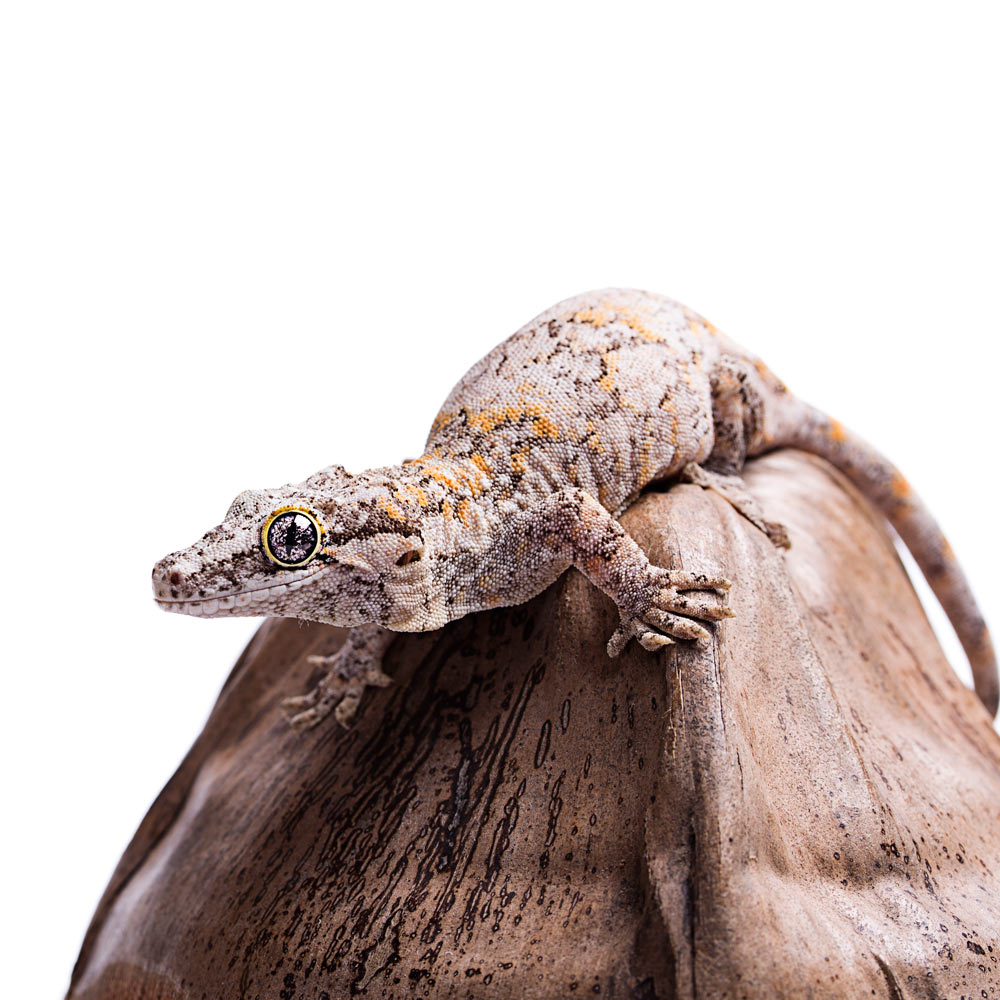
DIET | Omnivore – insects, flowers, sap, and small lizards
- They communicate by growls, squeaks, barks, and yips at night.
- These geckos have prehensile tails and specialized claws to climb trees.
- Like many geckos, gargoyle geckos can lose their tails and grow them back.
Giant day gecko
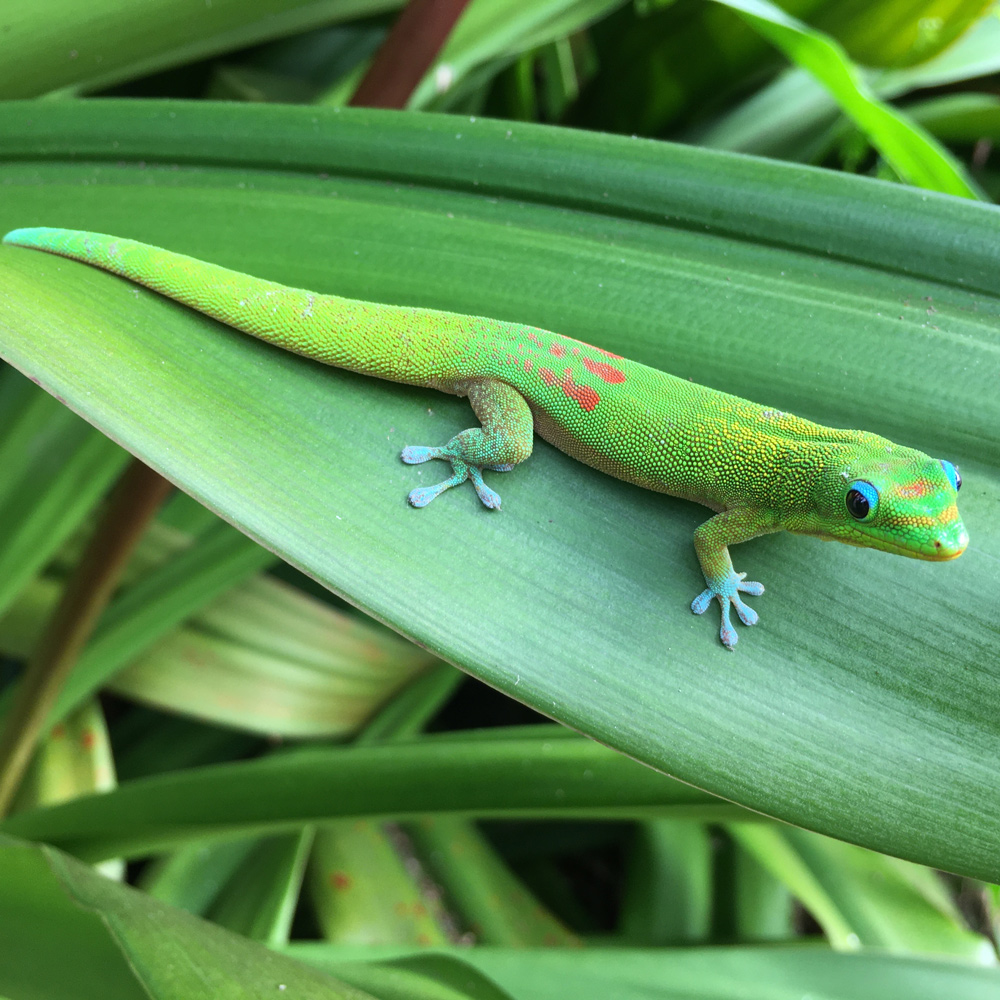
DIET | Omnivore – insects, fruit, and nectar
- There are over 40 different species of day geckos discovered.
- They do not have claws; their fingers have small, flat, adhesive scales (lamella) that allow them to climb smooth surfaces.
Gray tree frog
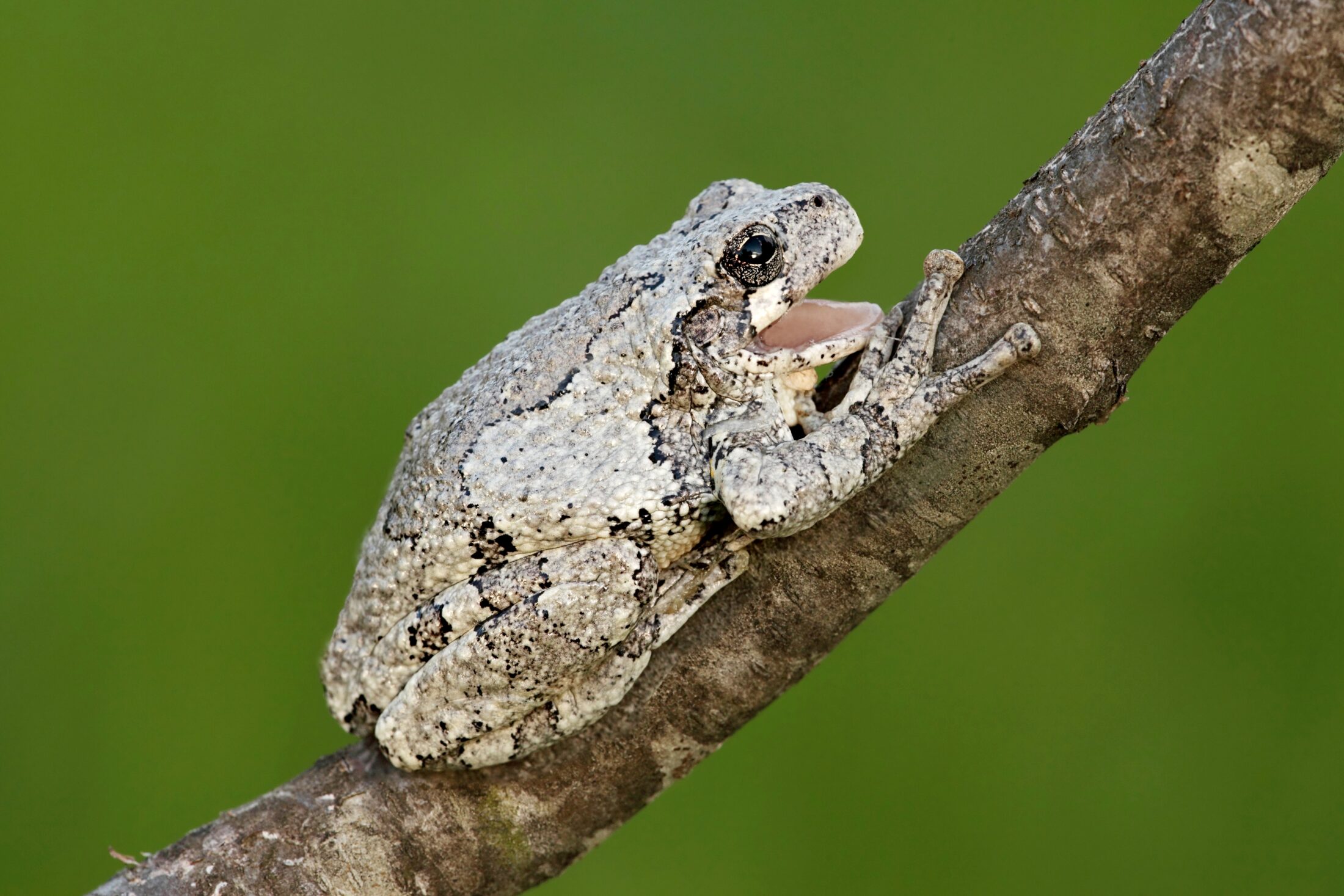
DIET | Carnivore – insects and other smaller frogs
- These highly arboreal frogs are found in forested areas.
- It prefers to breed in semipermanent woodland ponds without fish, but it also lays eggs in swamps, vernal pools, man-made fountains, water gardens, and even in rainwater-filled swimming pool covers.
- Their gray color serves as camouflage within densely wooded areas. Their skin can assume the most natural colors with which it comes into contact, helping it to blend in perfectly.
Green iguana
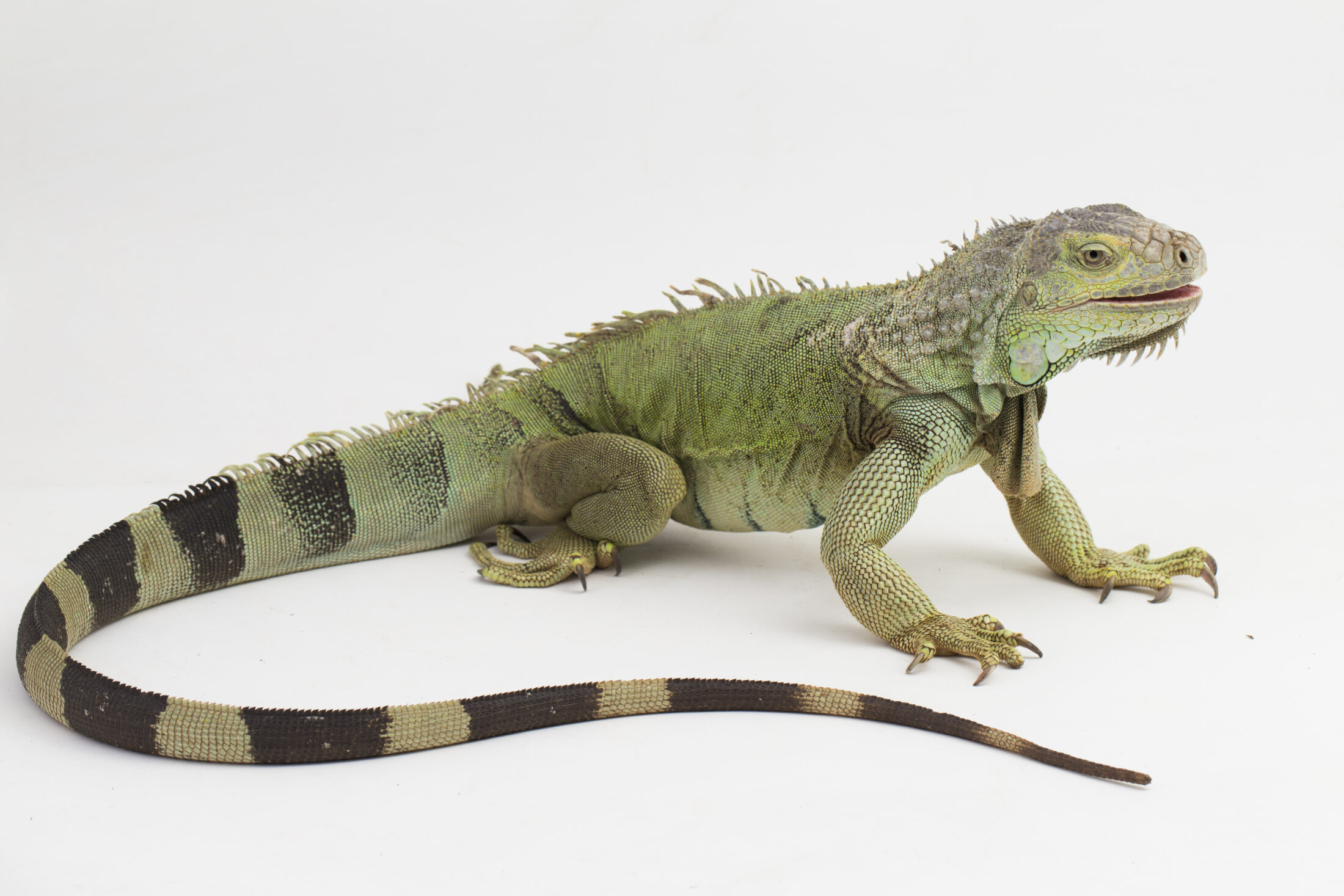
DIET | Mostly herbivorous –
Insects, leaves, and
berries.
- Green iguanas, or common iguanas, are among the largest lizards in the Americas.
- They spend most of their lives in the tree canopies, descending only to lay eggs or change trees.
- Iguanas’ stout build gives them a clumsy look, but they are fast and agile on land.
- They have strong jaws with razor-sharp teeth and sharp tails.
Horsfield’s Tortoise (Russian Tortoise)
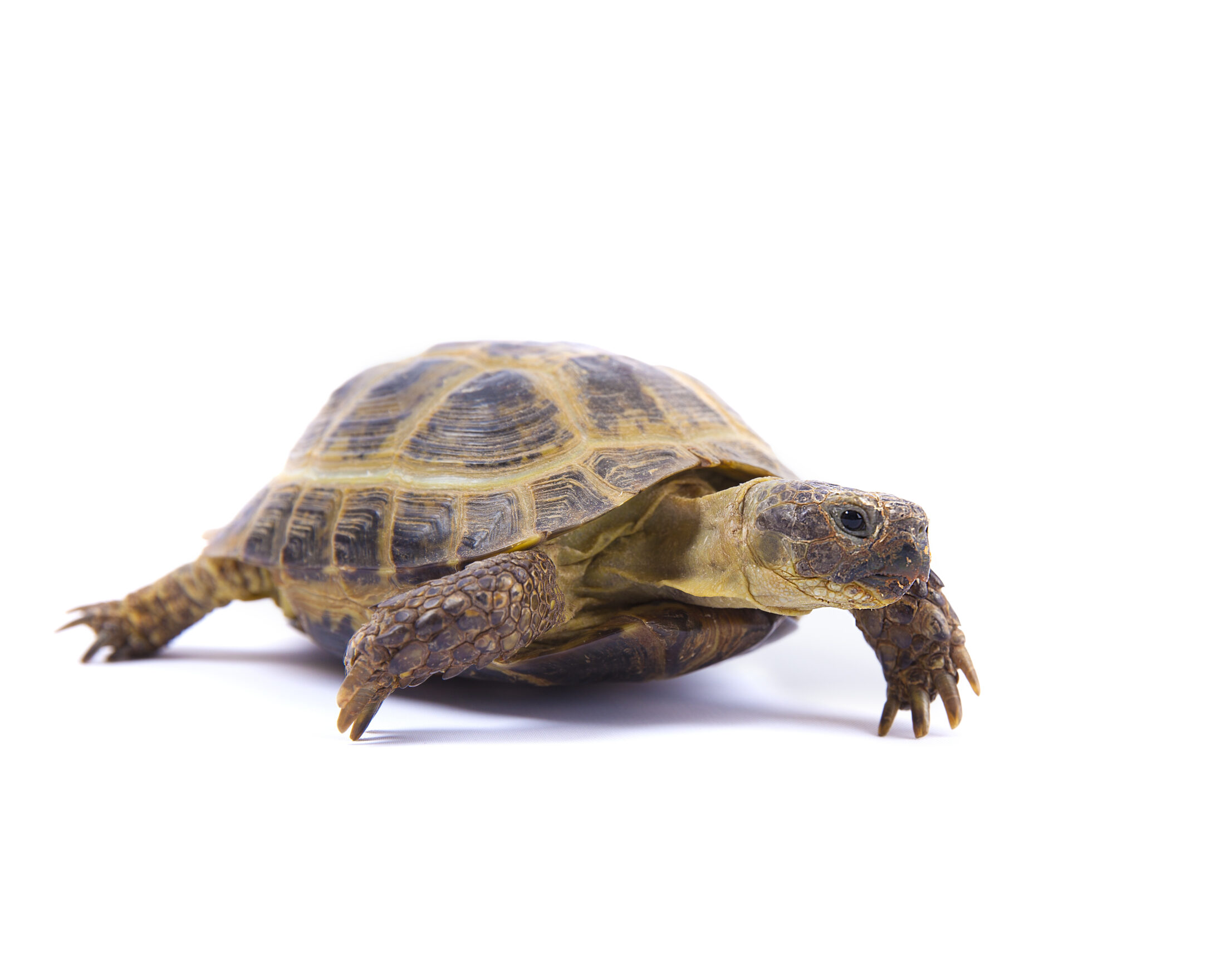
DIET | Herbivore – grasses, twigs, flowers, and some fruits.
- Russian tortoises have four toes on each foot.
- The male Russian tortoise courts a female by headbobbing, circling and biting her forelegs.
- On average, Russian tortoises will hibernate for about eight weeks to five months throughout the year if the conditions are right. The species can spend as much as nine months of the year in dormancy.
- These tortoises are pretty social, and they will visit nearby burrows, and sometimes several will spend the night in one burrow.
- Tortoises have both an exoskeleton and an endoskeleton. A shell is in three main parts: the carapace on the top, the plastron on the bottom, and the bridge that joins these pieces together. Every tortoise has ribs, a spine, and a collarbone inside its shell.
Leopard frog
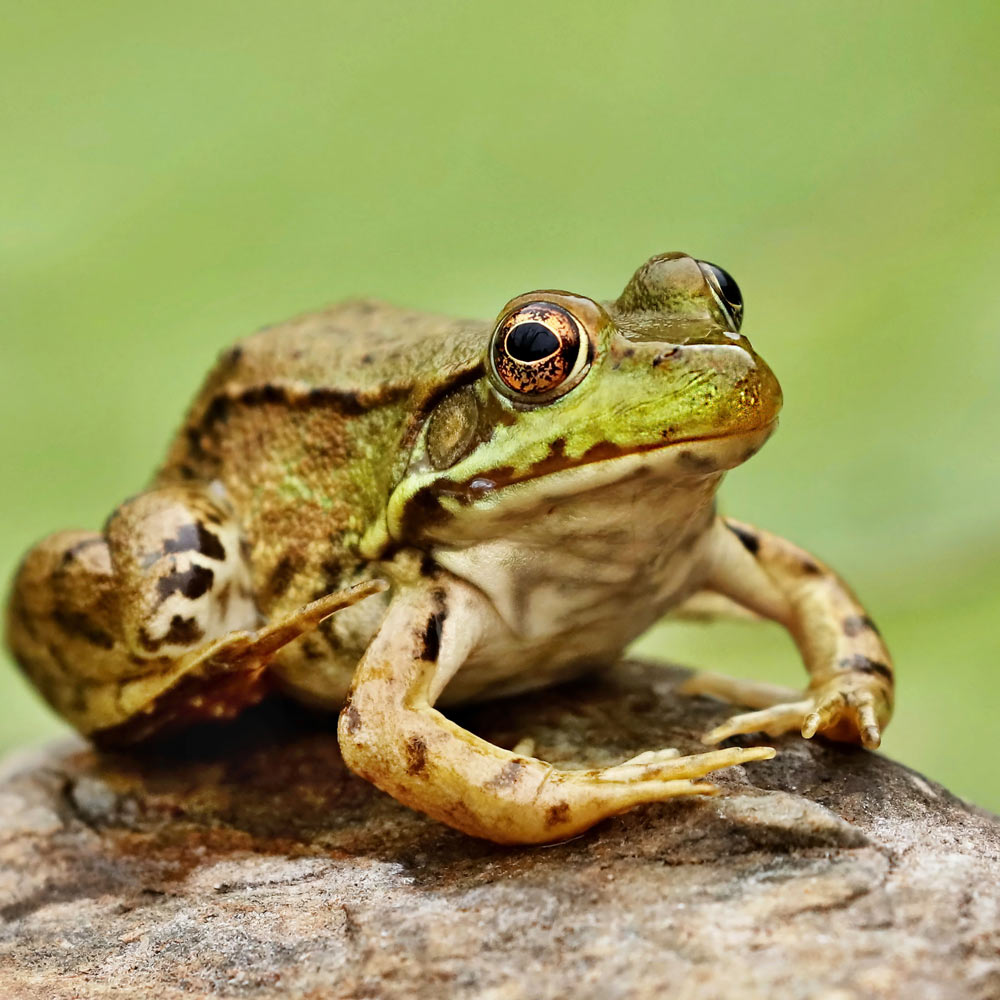
DIET | Carnivore – ants, beetles, flies, worms, smaller frogs, birds, and other small animals
- Leopard frogs can jump up to three feet high.
- These frogs are solitary creatures, and they only come together for mating.
- A female leopard frog can lay 7,000 eggs at one time.
Mata mata turtle
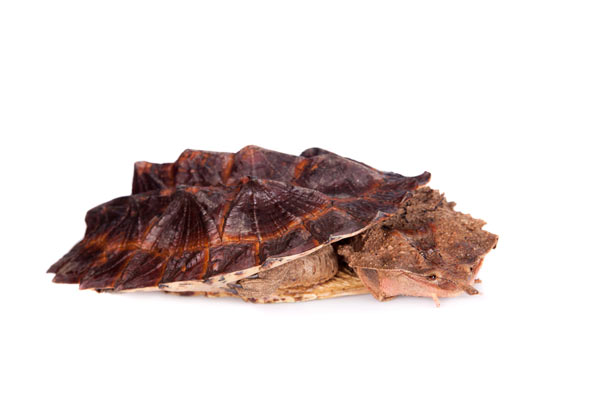
DIET | Carnivore – bottom feeders with a unique predation method that involves “vacuuming” up small fish and invertebrates
- They are primarily aquatic turtles, spending most of their time in slow-moving or stagnant bodies of water.
- They feed on small animals by suction feeding. When the turtle thrusts its head and opens its wide mouth as large as possible, it creates a low-pressure vacuum that sucks the prey into its mouth and swallows it whole.
Milk snake
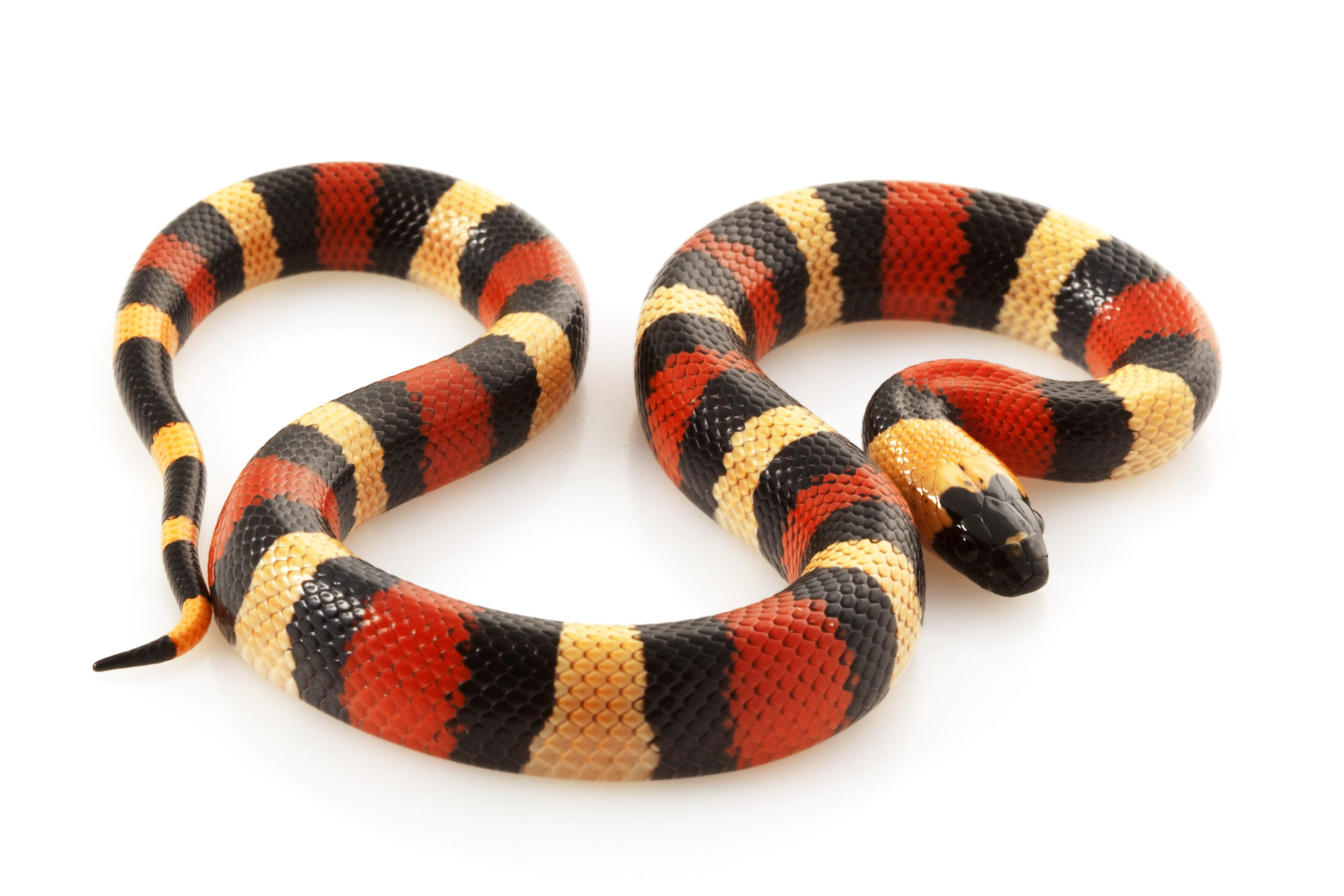
DIET | Carnivore – small rodents, birds, amphibians, lizards and other snakes, including venomous species.
- The milk snake mimics the coral snake in coloration, a venomous cobra. The milk snake, however, is not venomous.
- They got their name because an old myth reported that these snakes drank milk from cows. The truth was that the snakes were there to eat mice.
- They are primarily terrestrial and attempt to blend in with ground litter. However, they can climb and swim.
Painted turtle
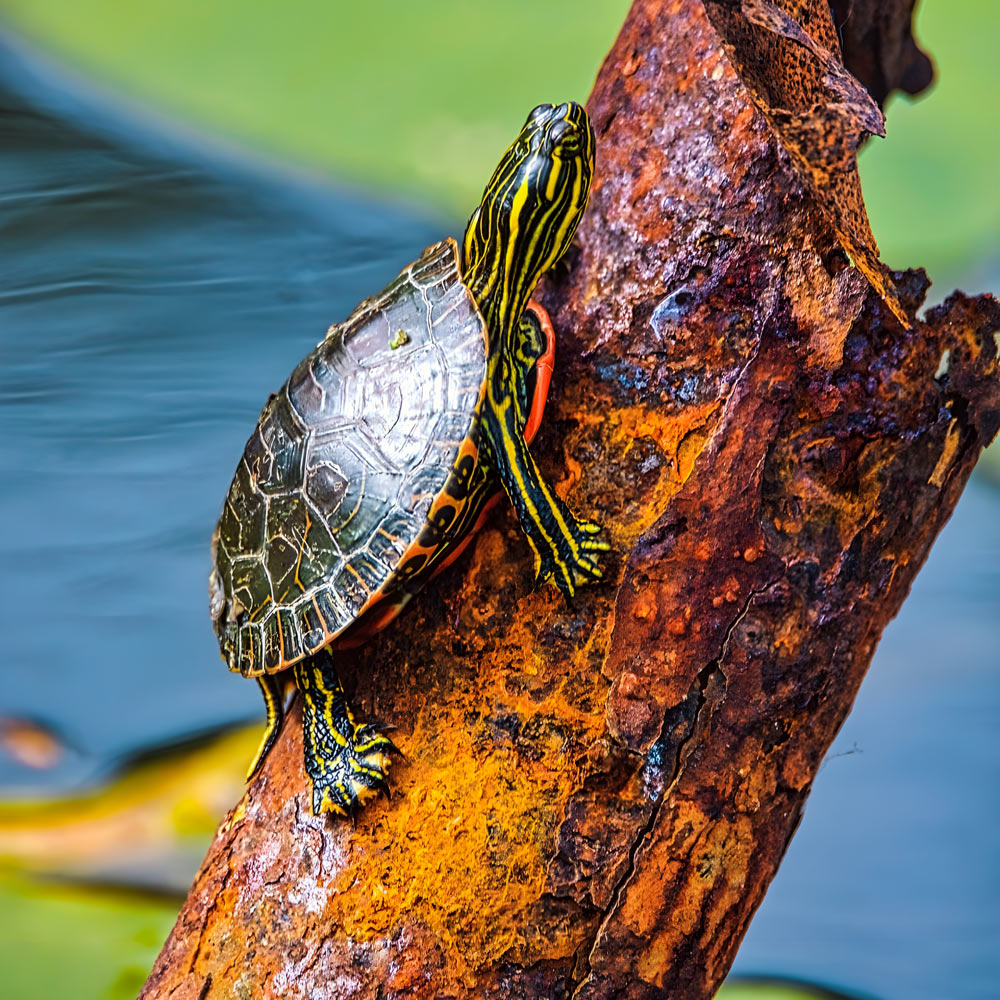
DIET | Omnivore – insects, small animals, fish, and vegetation
- During the winter, painted turtles lower their metabolism and body temperature to go into brumation (hibernation for reptiles).
- These turtles love the sun and come out of the water to bask in sun rays during the day.
Pixie Frog
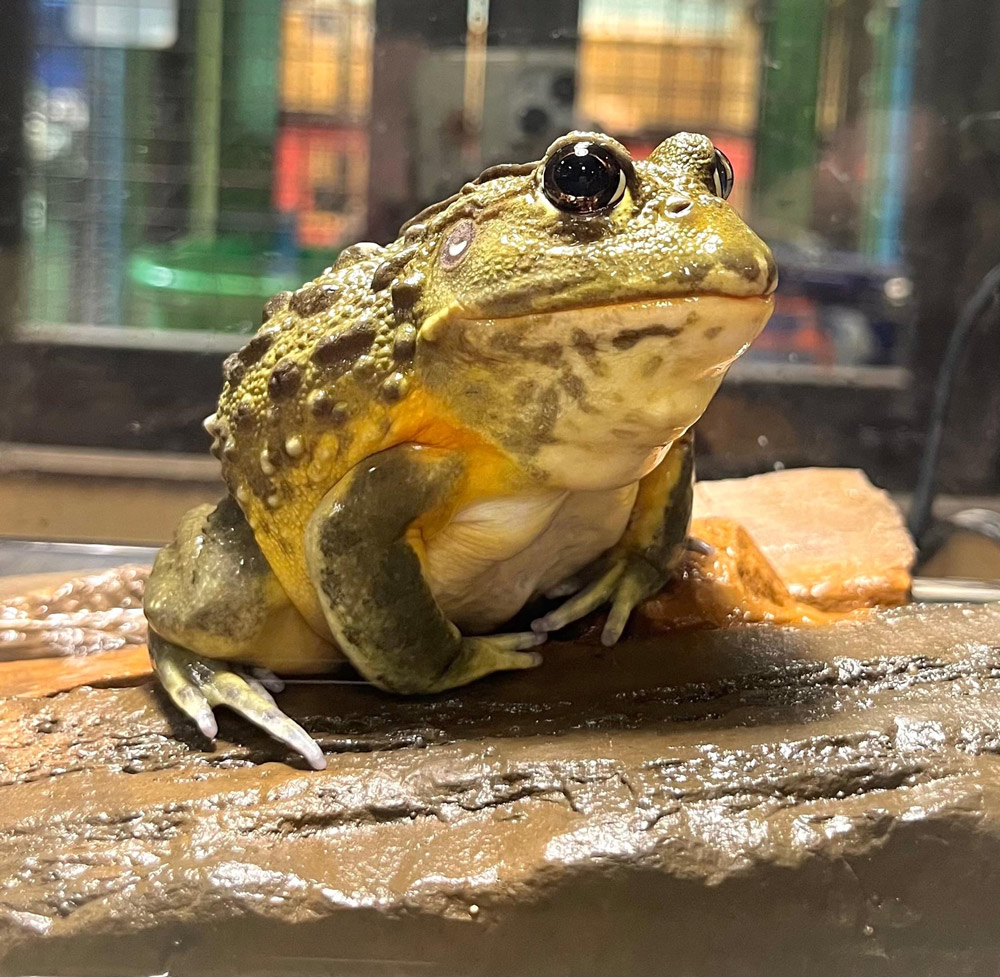
DIET | Carnivore – insects, fish, mice, birds, other frogs, reptiles, and small mammals.
- The African Bullfrog has teeth, and they will eat small mammals.
- They have giant clutches of eggs! They can have over 4,000 at a time!
- Males have a yellow or orange belly and throat. Females are beige underneath.
- Pixie frogs don’t chase their food; instead, they hide, waiting patiently, and ambush creatures that come close enough to be snatched up.
Red-footed tortoise
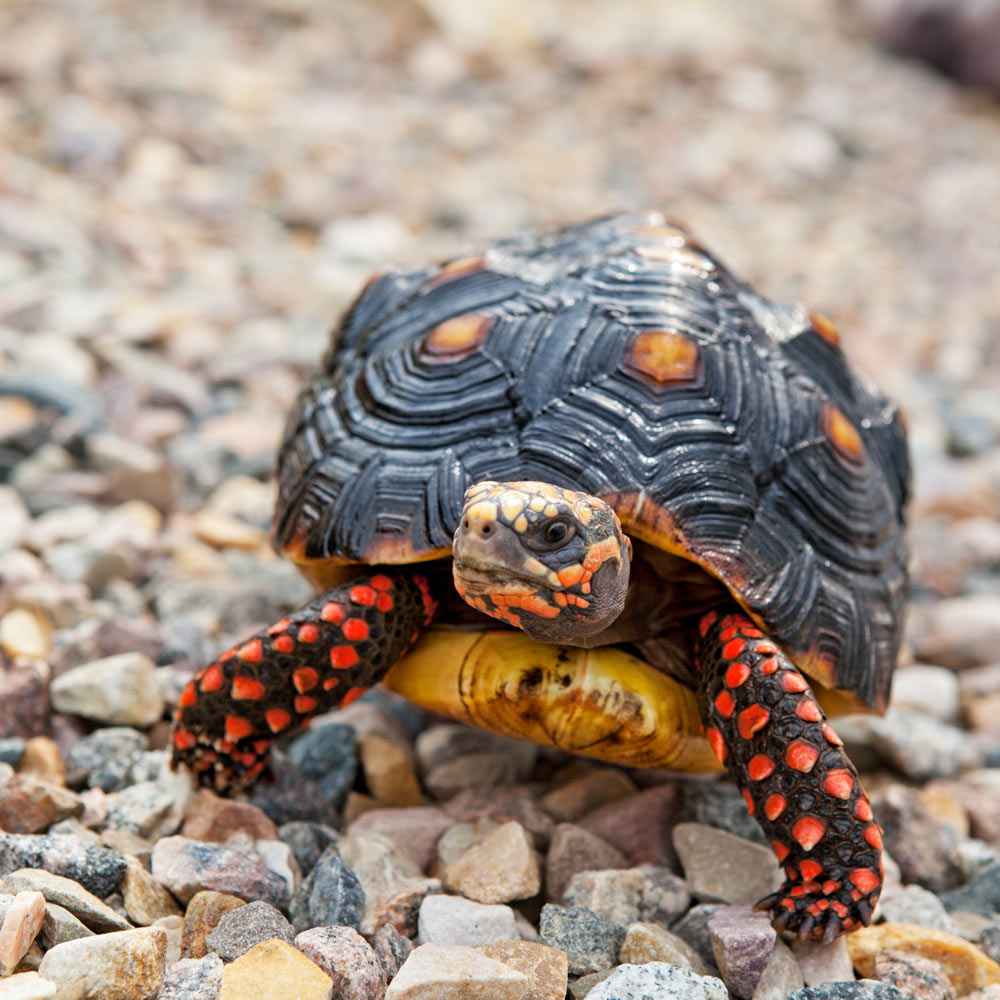
DIET | Herbivore – leafy greens, grasses, fungi, fruits, and flowers
- Both male and female red-footed tortoises use head movements to identify and alert one another.
- After mating, females can have five to 15 eggs.
- These tortoises spend over half of each day resting while hidden under leaves.
Tiger Salamander
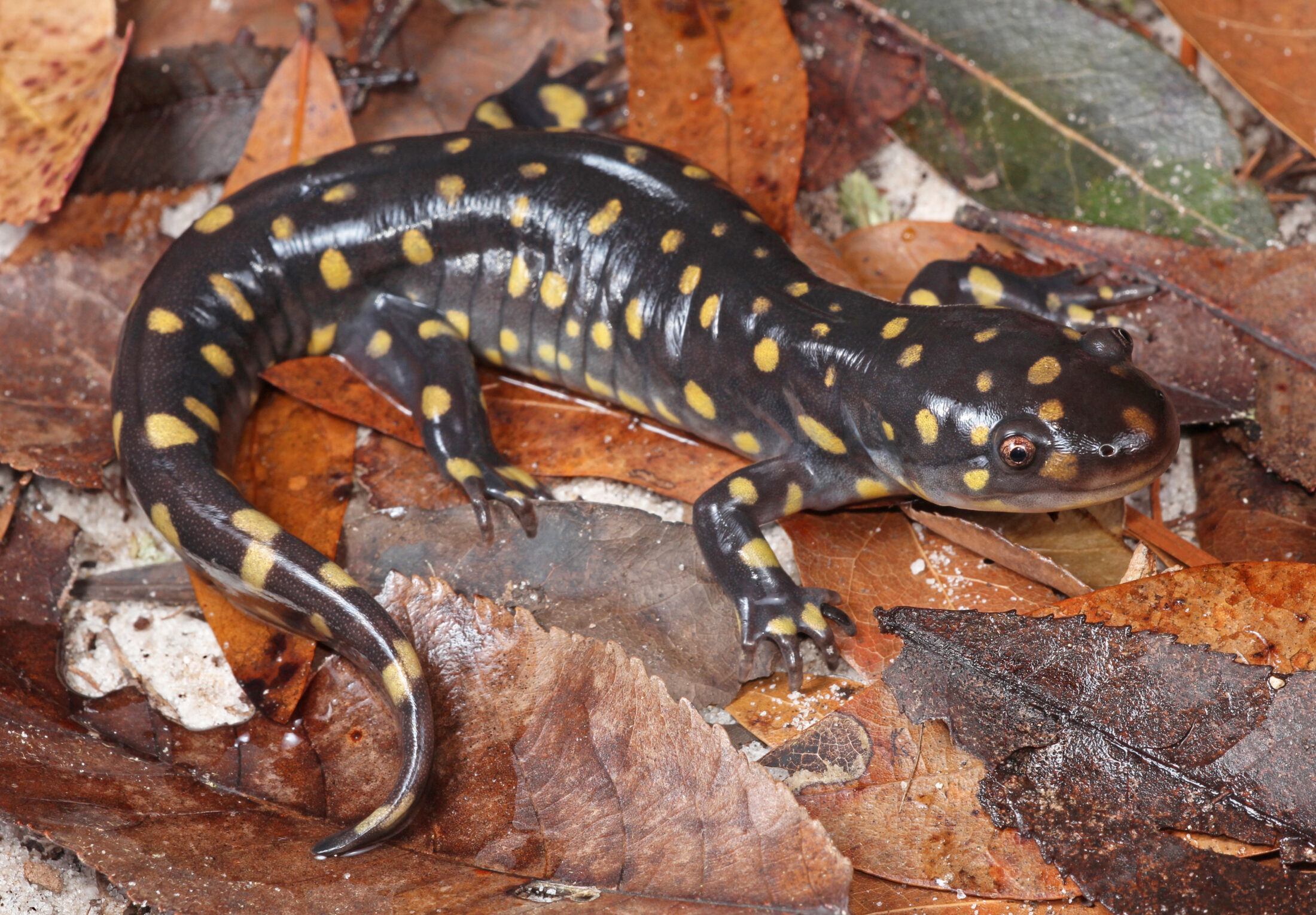
DIET | Carnivore – worms, snails, insects, and slugs
- Clutch size 20-30 eggs. The eggs only take 12-15 days to develop and hatch.
- The female lays the eggs on twigs and leaves at the bottom of a water pool.
- The larvas have external gills and are entirely aquatic.
- Salamanders have very sensitive and absorbent skin.
- Salamanders are very sensitive to environmental change and pollution and are what scientists call an “Indicator Species,” or a species that is very intolerant of pollution and environmental change.
Reptiles, Amphibians, and Fish coming soon:
- Ackie Monitor Lizard
- Milk Snake
- Ocellate River Stingray
- Rosy Boa
Birds
Emu (with video)

DIET | Herbivore – seeds, fruits, flowers, and young shoots
- The Emu is not a very intelligent animal. Their eyes are larger than their brain!
- While they are flightless, they are excellent runners and swimmers.
- The emu is a part of the ratite family, including the cassowary, ostriches, and rheas.
- Back in 1932, Australia waged war on a large population of emus that were raiding farmers’ crops. Humans lost the war.
- Emu lays green eggs!
Leghorn chicken

DIET | Omnivore – greens, seeds, insects, larvae, worms, other invertebrates, and even small animals.
- This breed originated in Tuscany, central Italy.
- Birds were first exported to North America in 1828 from the Tuscan port city of Livorno on the western coast of Italy. They were initially called “Italians”, but by 1865 the breed was known as “Leghorn.”
- The name comes from Leghorn, the traditional anglicization of Livorno, the Tuscan port from which the first birds were exported to North America.
- This breed comes in three colors: black, white, and brown (light and dark)
- Leghorns are good layers of white eggs, laying an average of 280 per year and sometimes reaching 300–320.
Orpington chicken

DIET | Omnivore – greens, seeds, insects, larvae, worms, other invertebrates, and even small animals.
- The original Black Orpington was bred by William Cook in 1886 by crossing Minorcas, Langshans, and Plymouth Rocks to create a new hybrid bird.
- These chickens are named for their original breeding location — Orpington, England.
- Colors of this breed include: Blue, Black, Buff, White (Standardised UK) Birchen, Chocolate, Cuckoo, Gold Laced, Jubilee, Lavender, Lemon Cuckoo, Partridge, Red, Spangled (Non-Standardised).
Parakeet / Budgerigar (with video)

DIET | Herbivores – seeds, fruits, and vegetation
- Parakeets are native to Australia and are known as “budgies.”
- They have fast-growing beaks that can grow over three inches a year. They need to chew on branches or toys to wear down their beaks so they don’t overgrow!
- They have acute vision and can even move each of their eyes independently.
- Female parakeets have pink or brow ceres, while males have blue/purple cere. The cere is the tiny bit of skin around their nostrils.
Polish chicken (with video)

DIET | Omnivore – greens, seeds, insects, larvae, worms, other invertebrates, and even small animals.
- Polish chickens are bred primarily as ornamental birds, and in the case of show-quality birds, for show, but were initially productive egg layers.
- In present times, they are rarely broody or sit on the eggs they lay.
- The Polish has a small V-shaped comb, though the large crest of feathers often hides it. The earlobes and wattles are small and may be completely hidden by the crest.
- Polish chickens were brought to America between 1830 and 1840.
- Polish chickens lay white eggs.
Victoria-crowned pigeon

DIET | fallen fruits, berries, seeds, and occasionally small invertebrates.
- This species was named in honor of the British monarch, Queen Victoria.
- It is considered the largest surviving species of pigeon on Earth.
- Victoria-crowned pigeons spend most of their time on the ground and fly up into trees only when disturbed or to roost at night.
- Victoria crowned pigeons are monogamous and mate for life.
- Like other crowned pigeons, the Victoria crowned pigeon is a gregarious species. The Victoria crowned pigeon often gathers in groups of 2-10 individuals. They usually travel in pairs or small parties as they search for food.
Birds coming soon:
- Ancona Duck
- Bronze Turkey
- Cape Barren Goose
- East African Crown Crane
- Guinea Hens
- Nene Goose
Insects, Arachnids, + Invertebrates coming soon:
- Blue Feigning Death Beetle
- Bumblebee Millipede
- Giant Millipede
